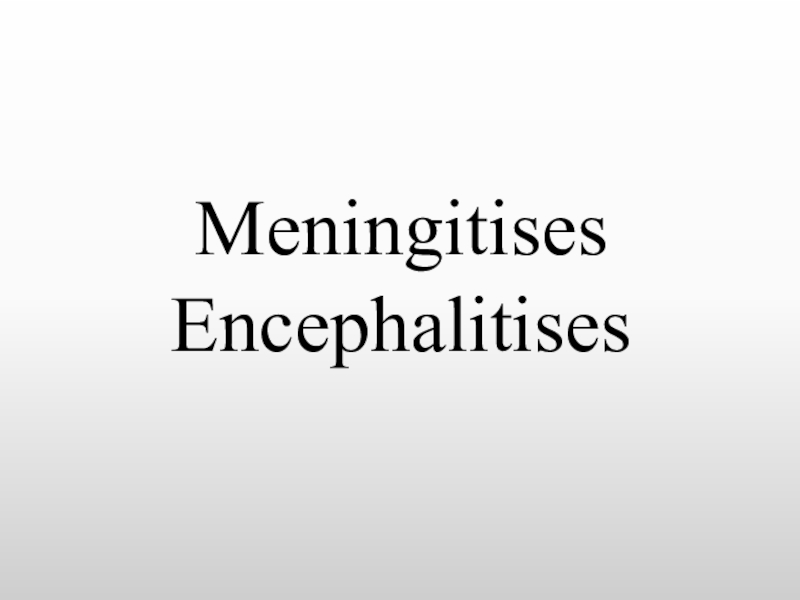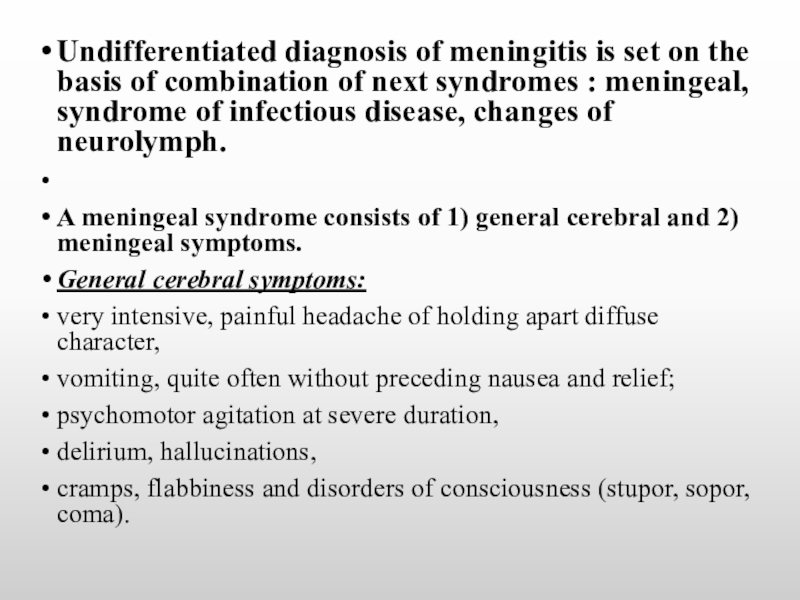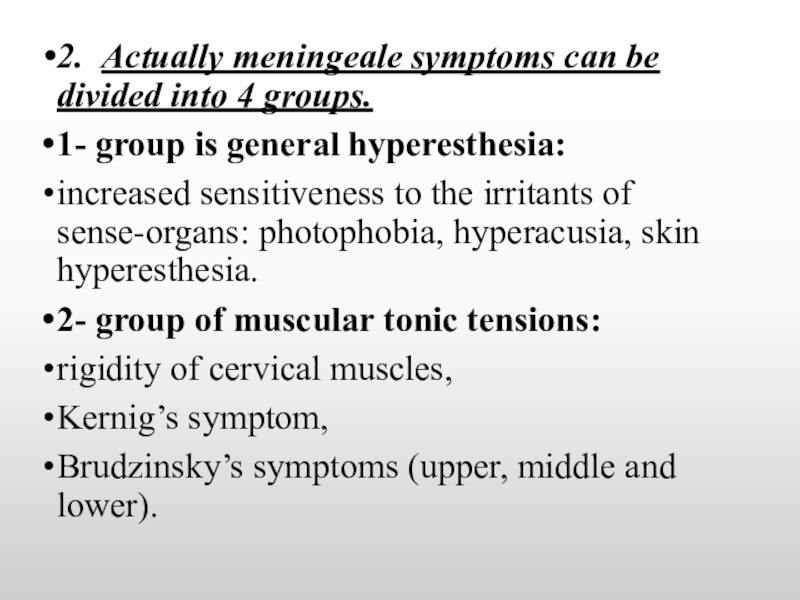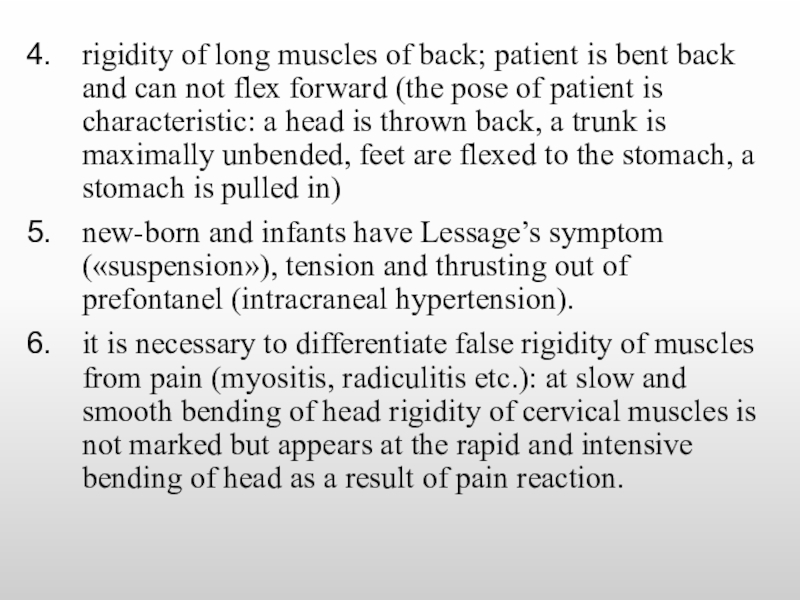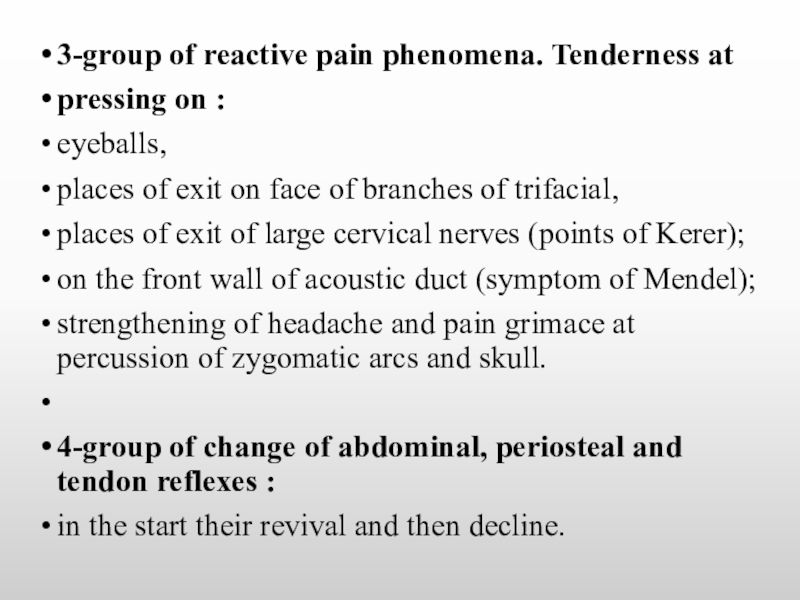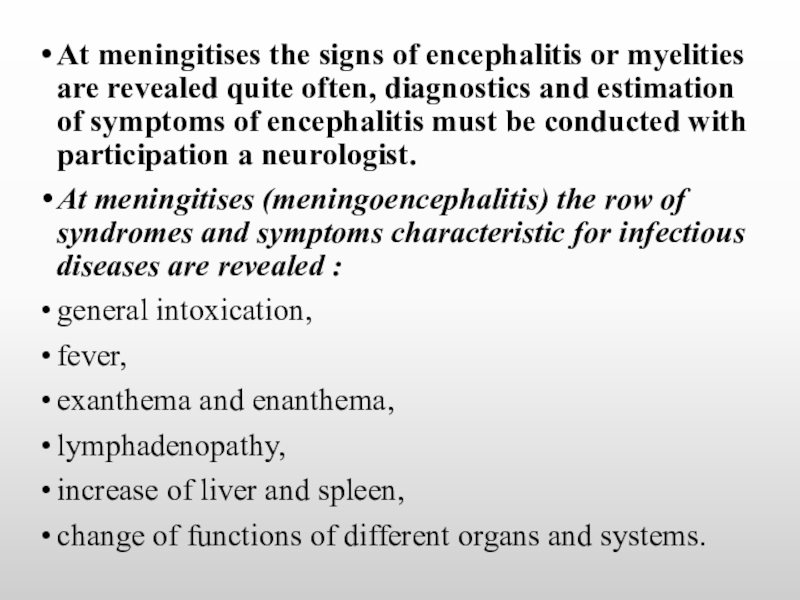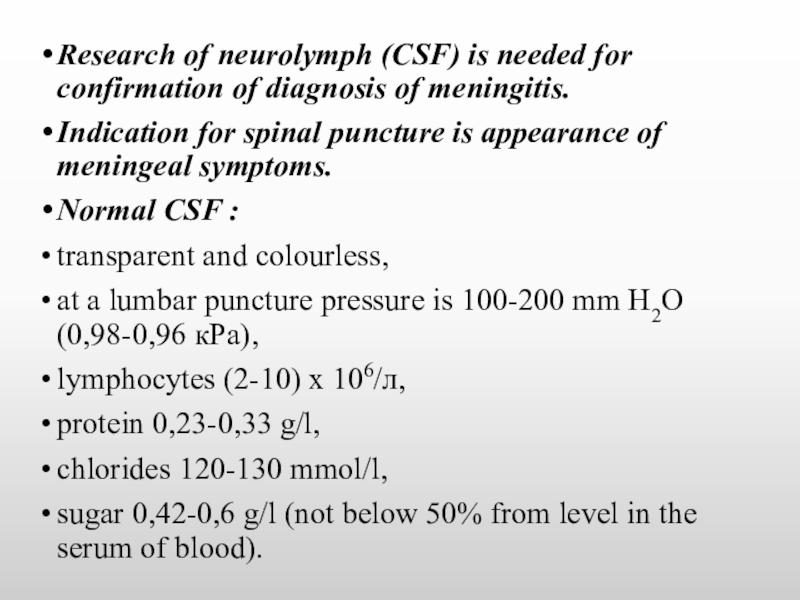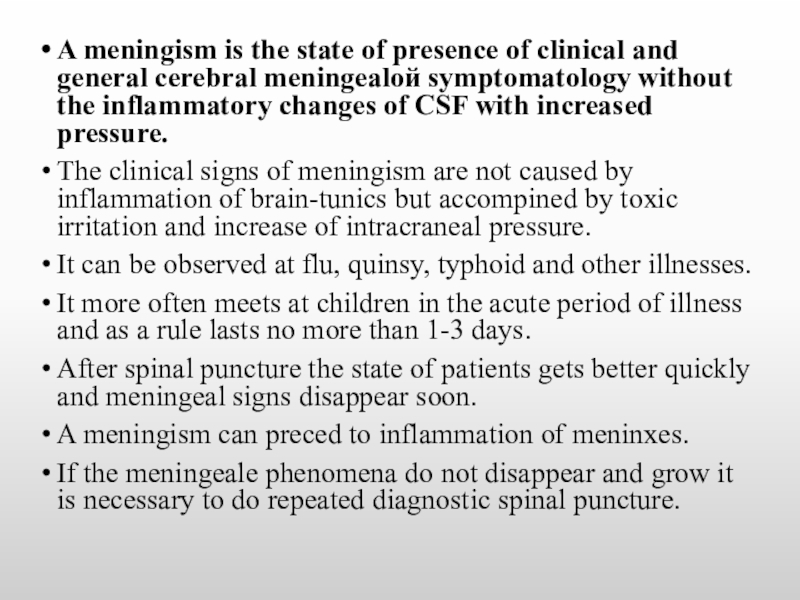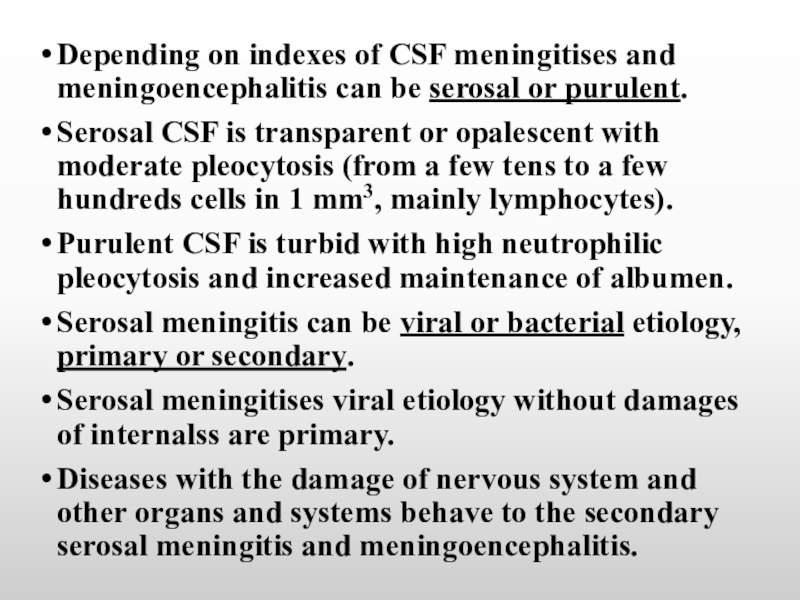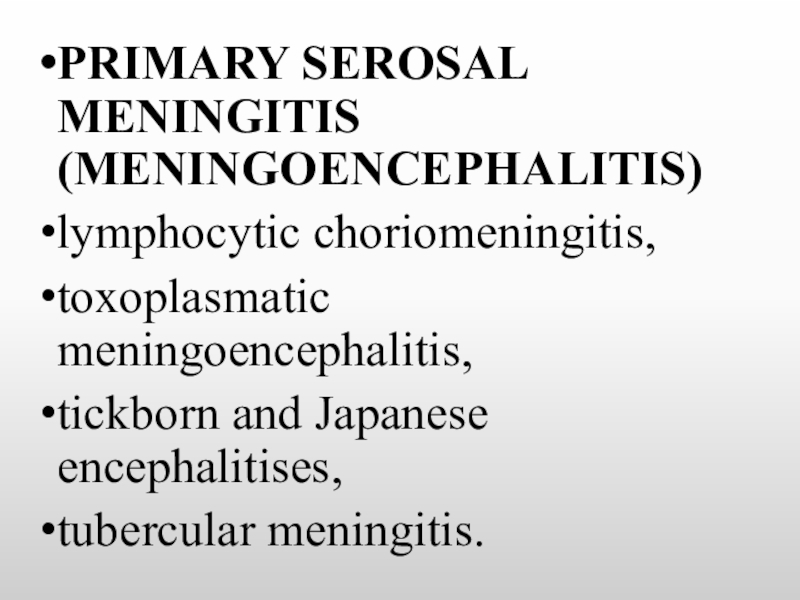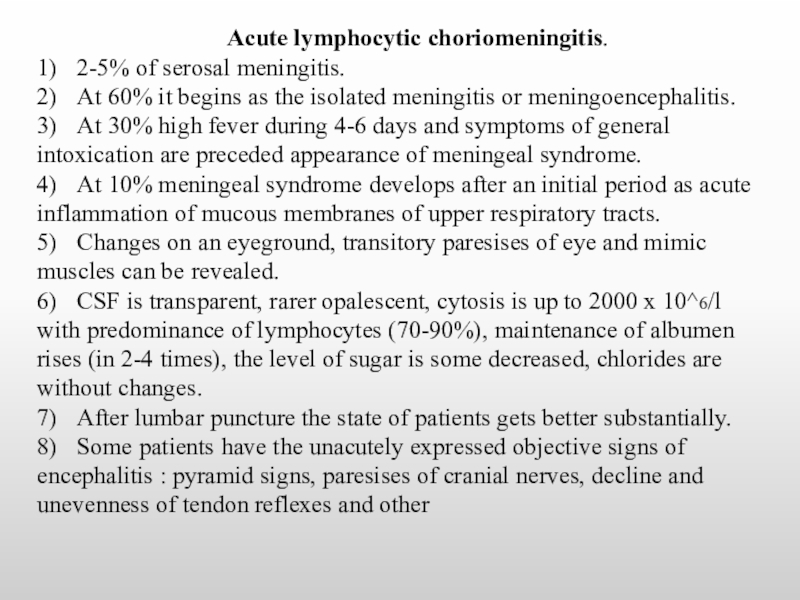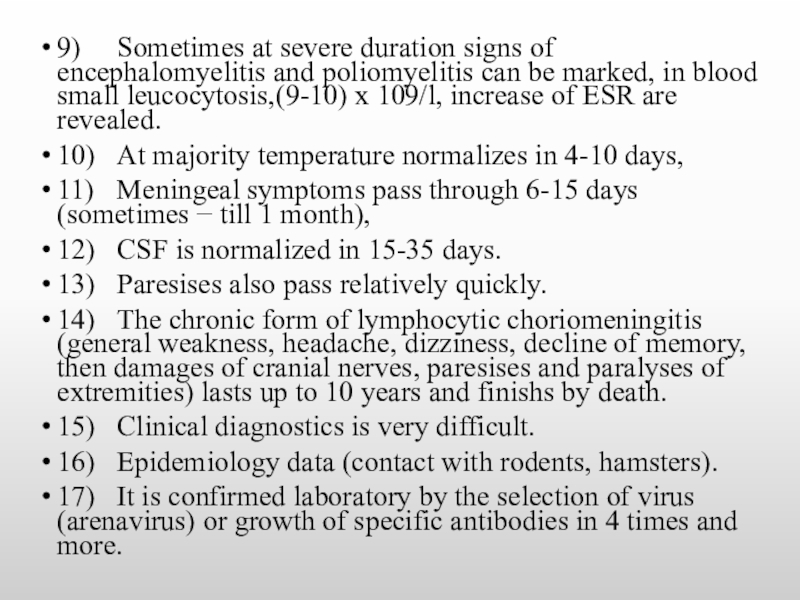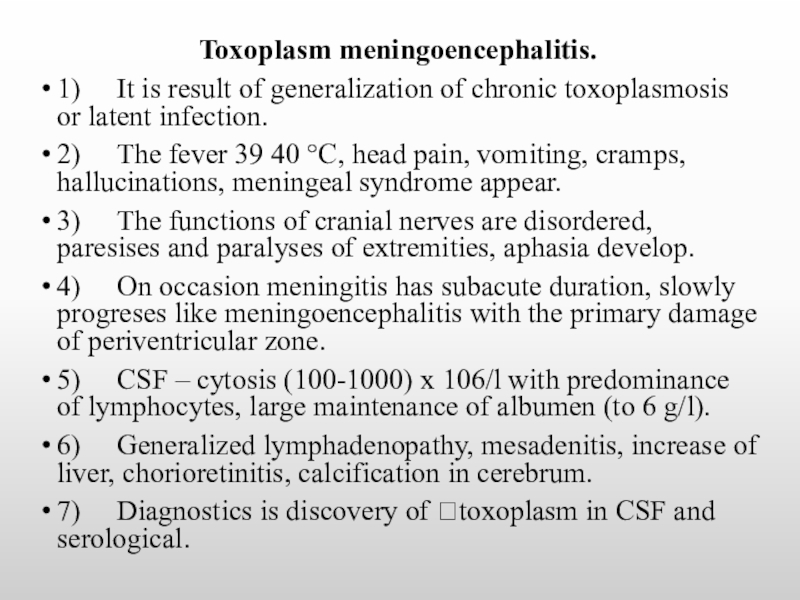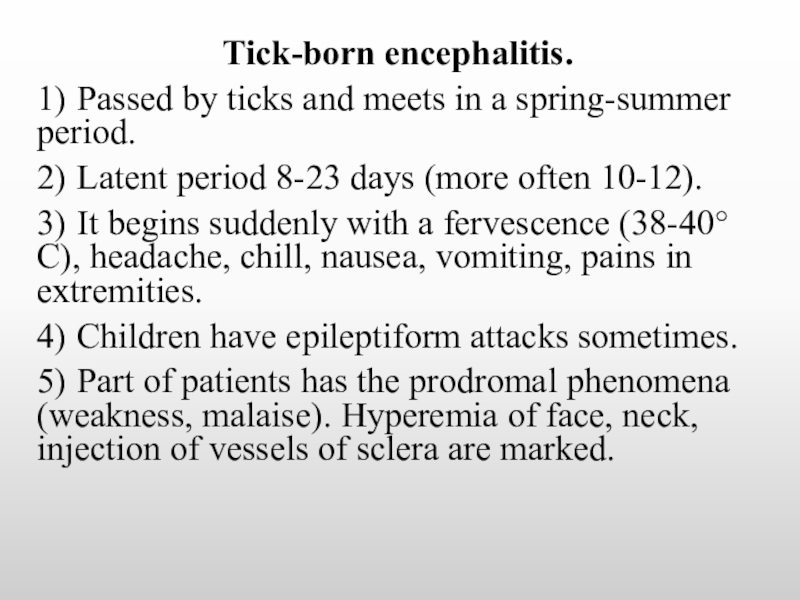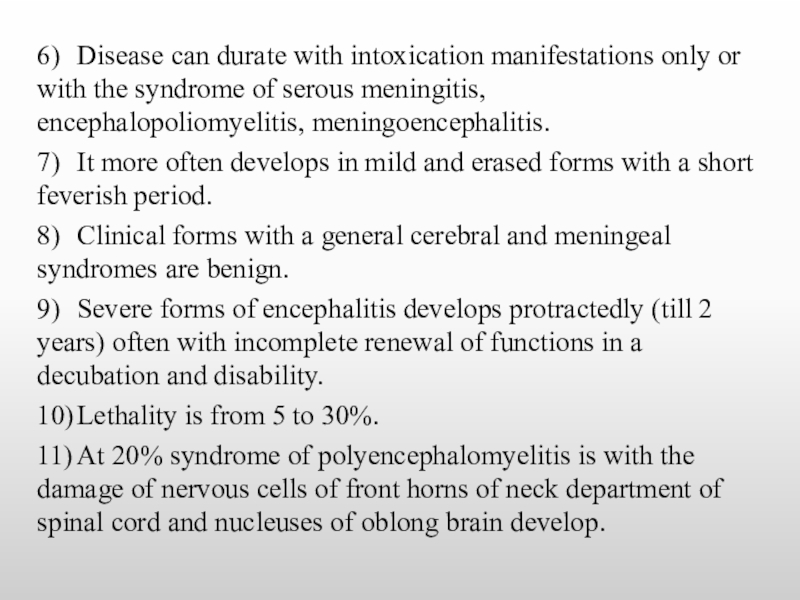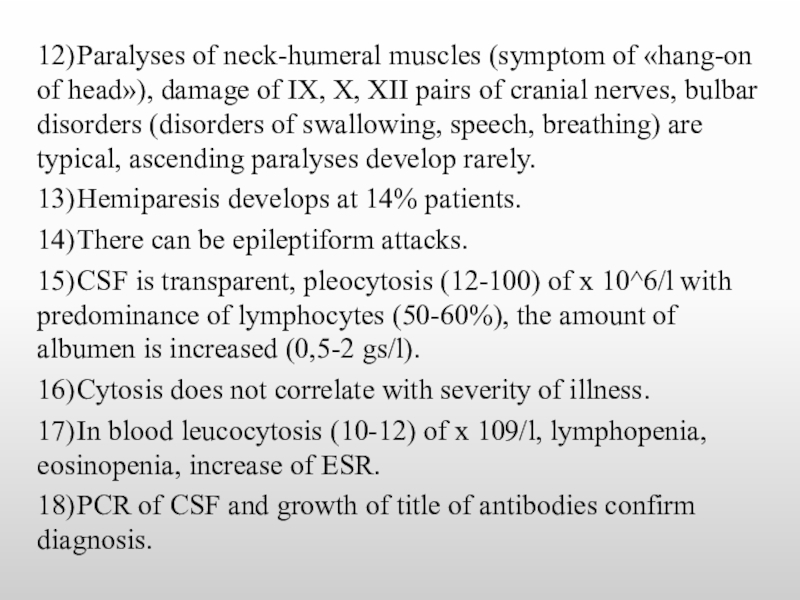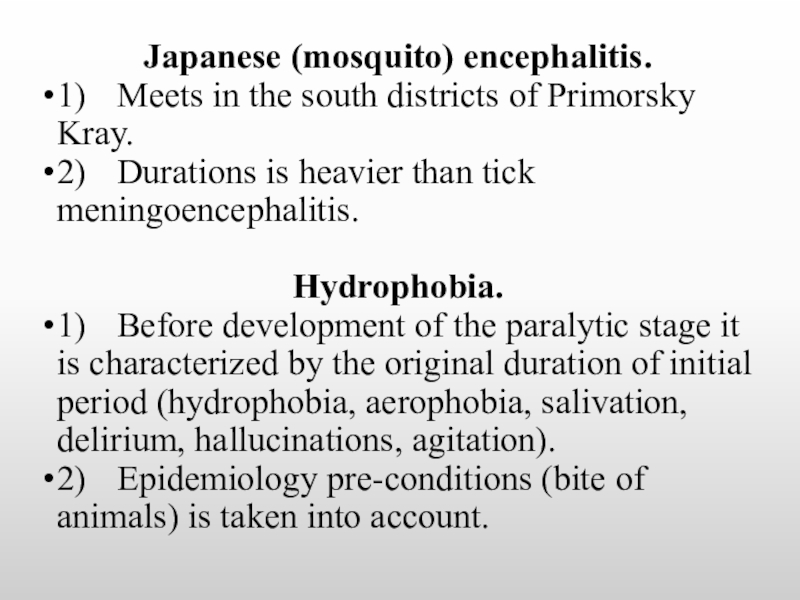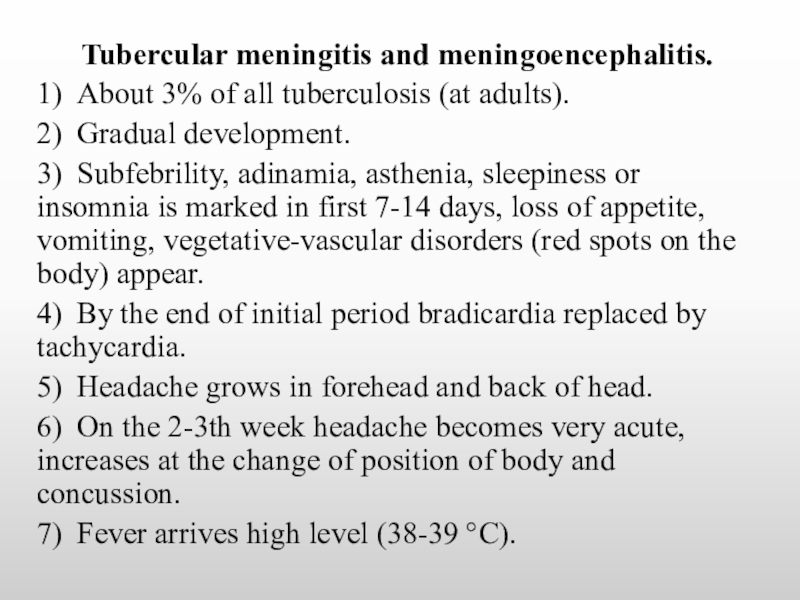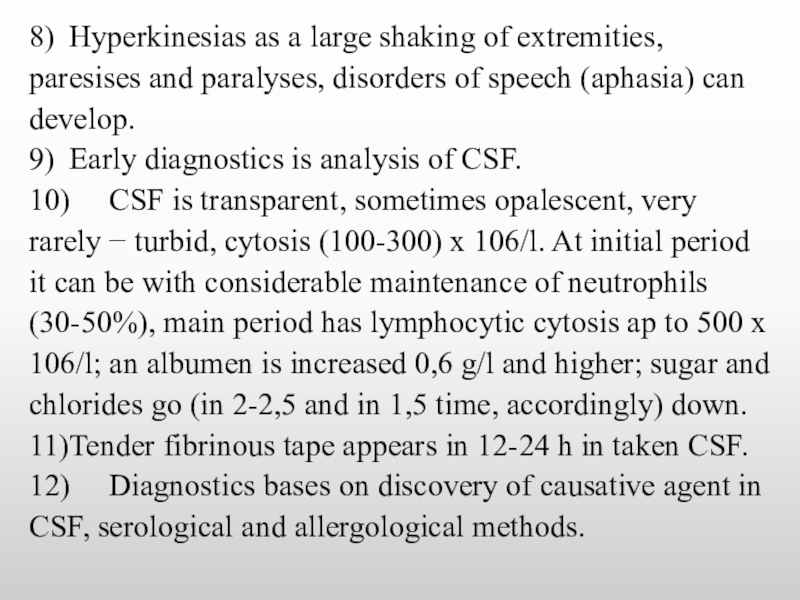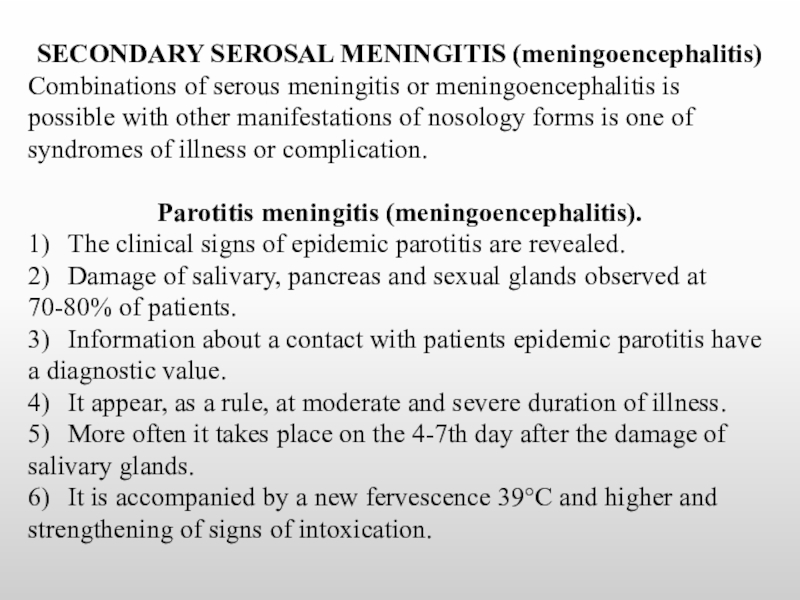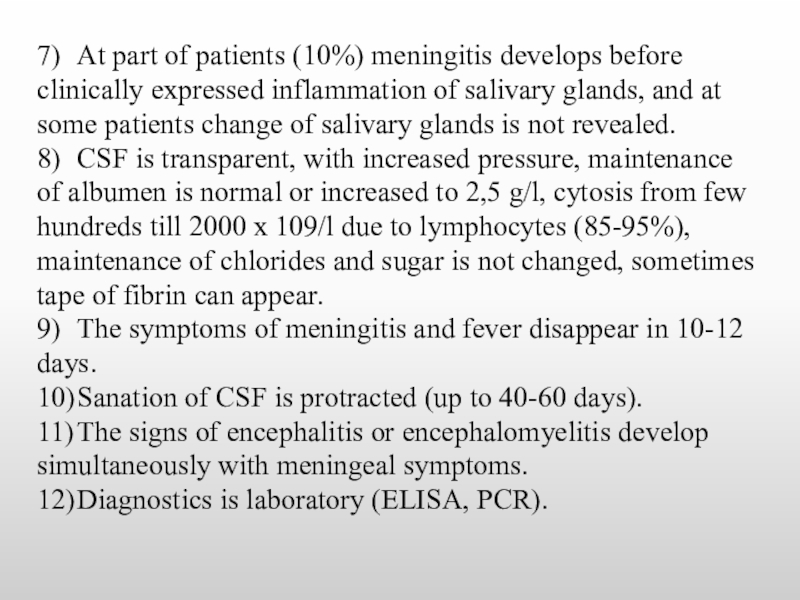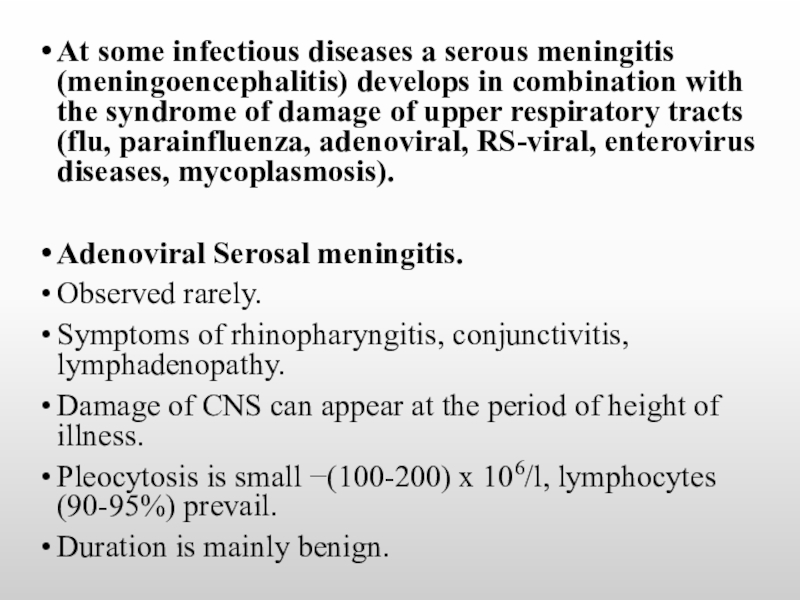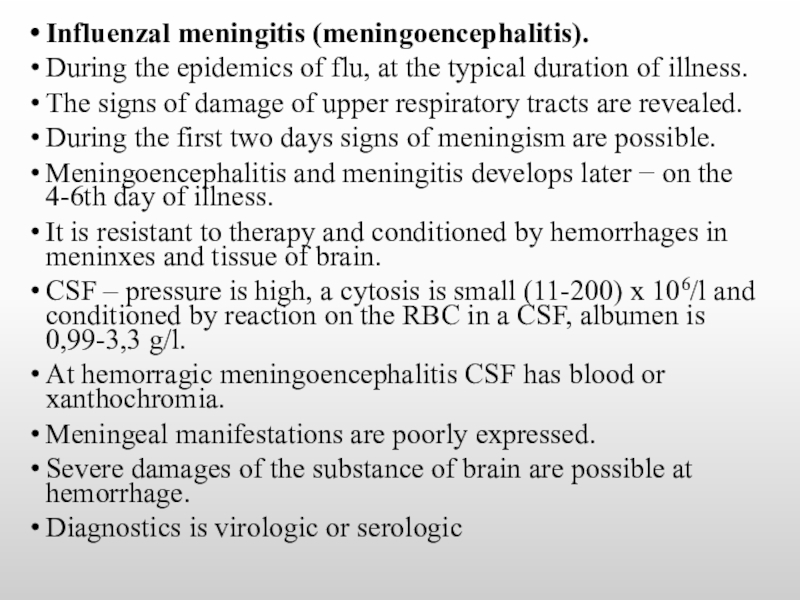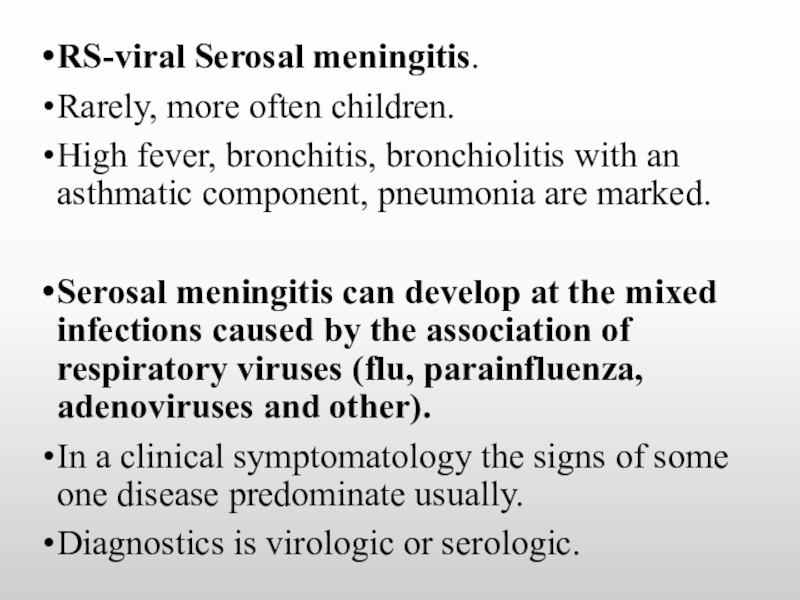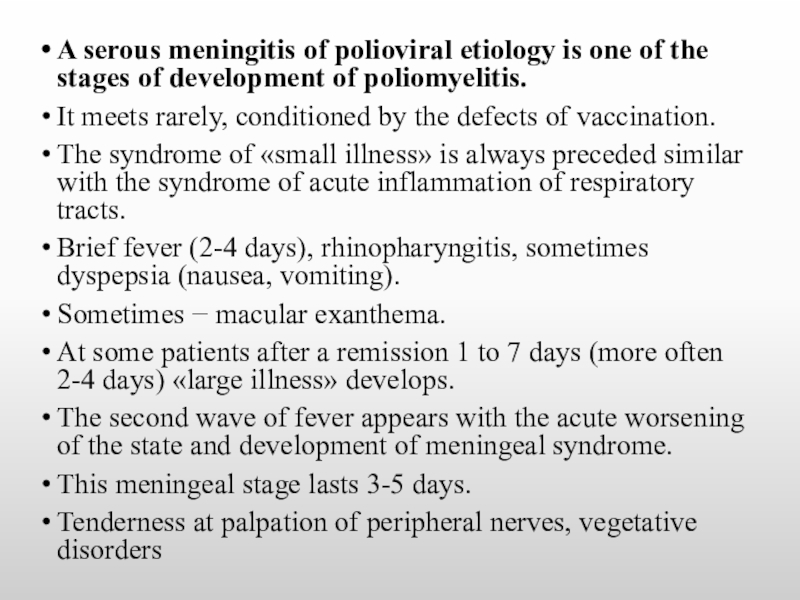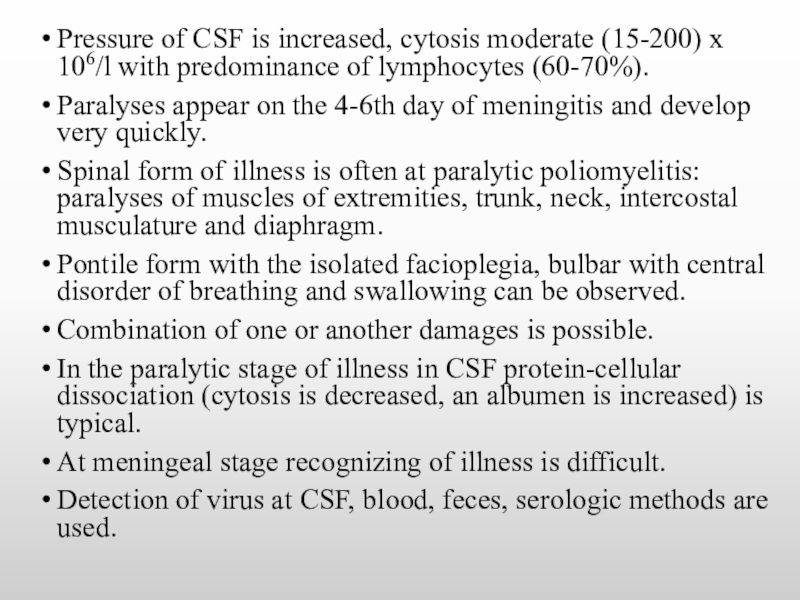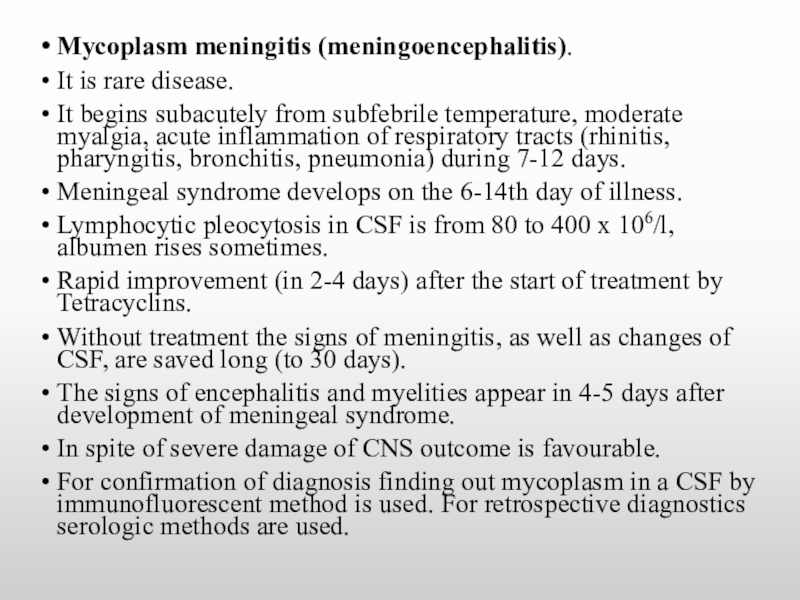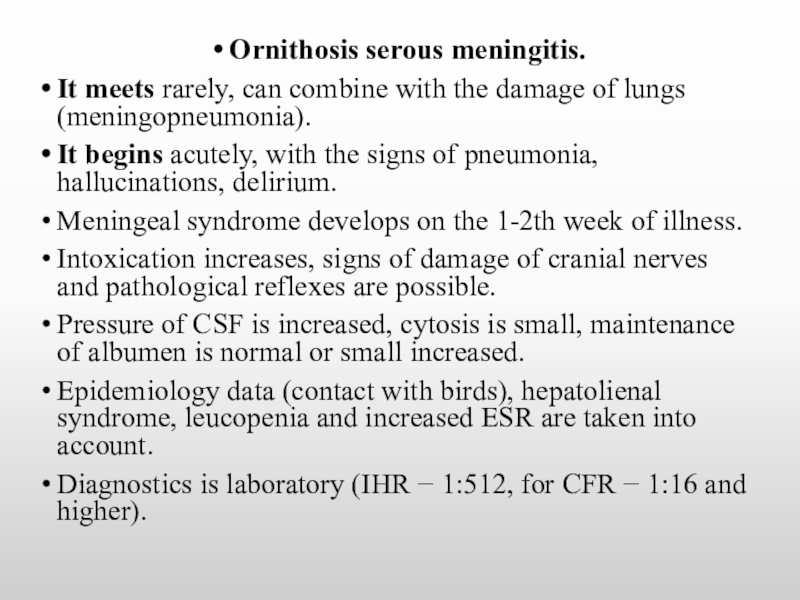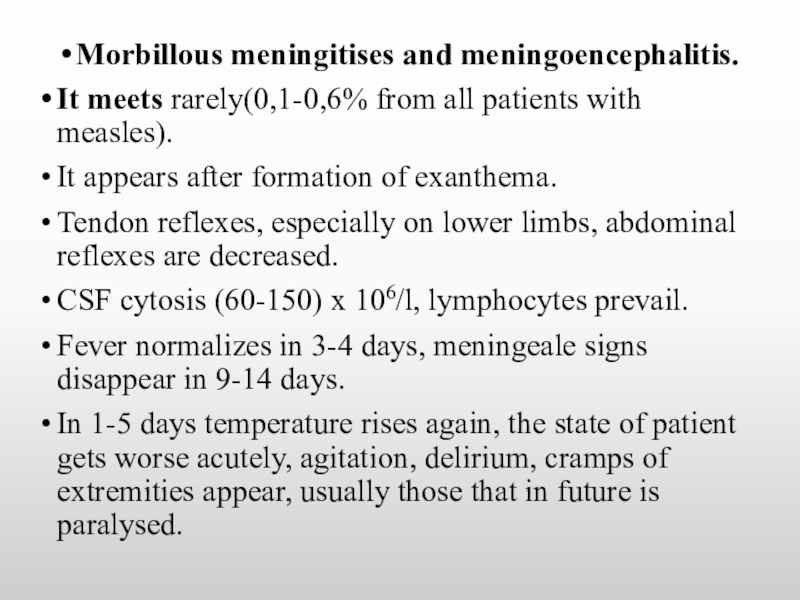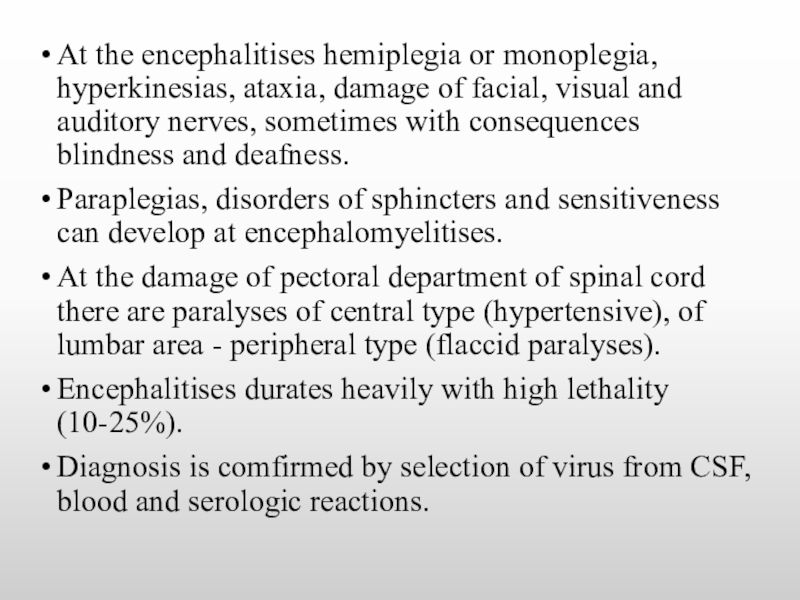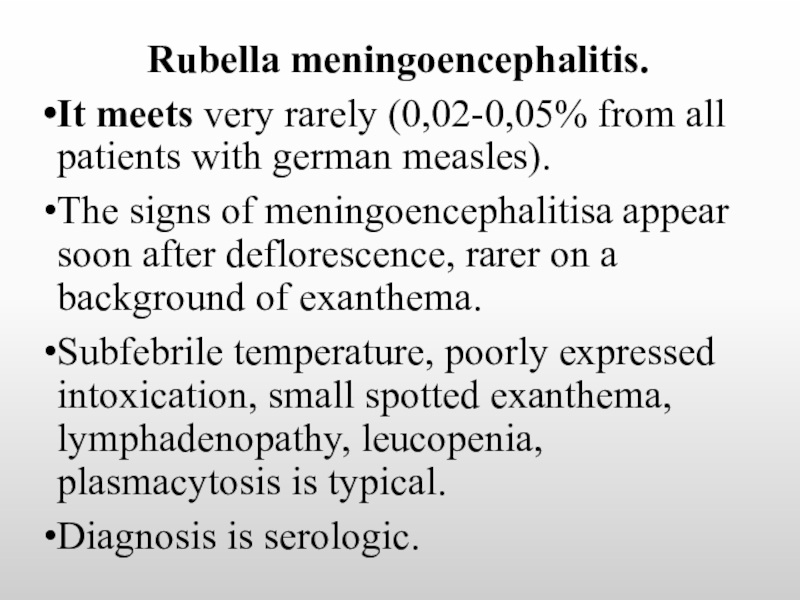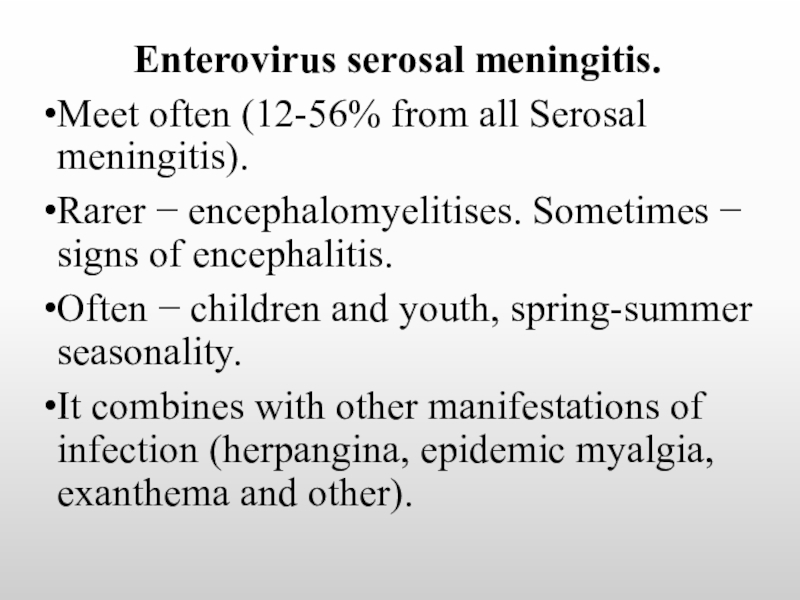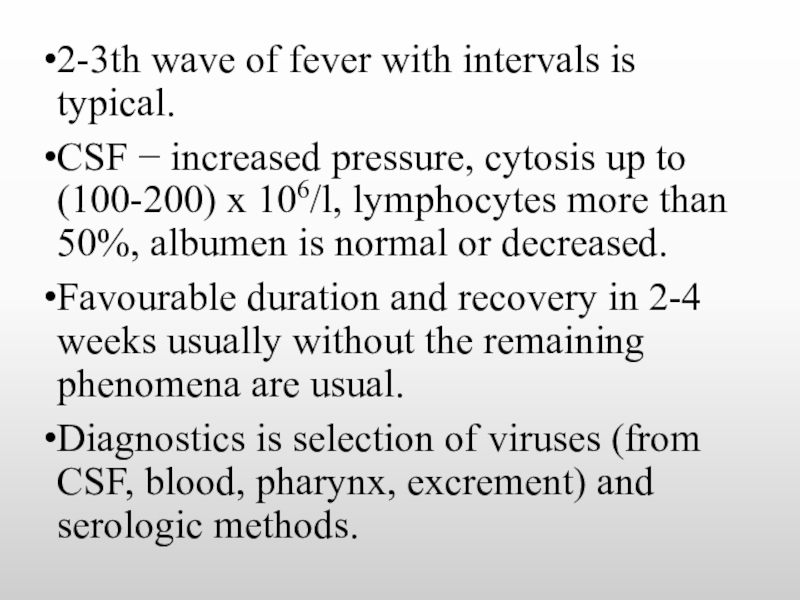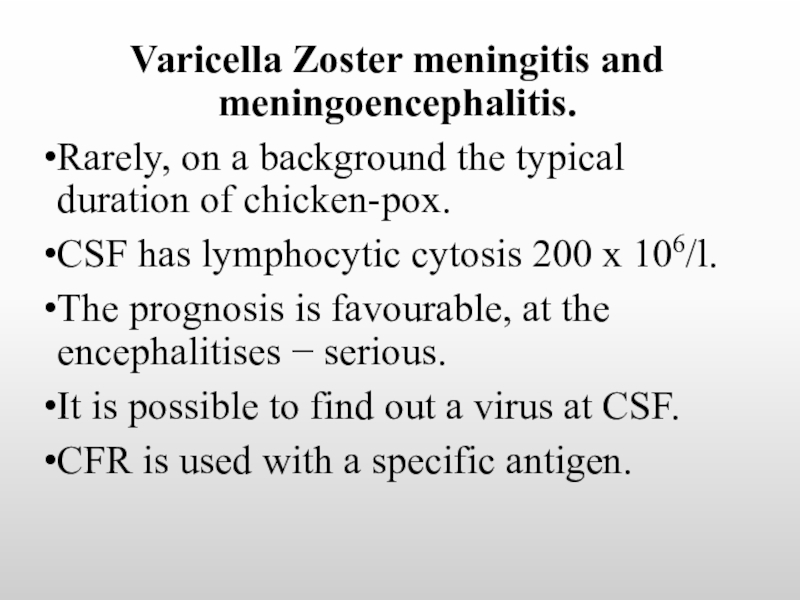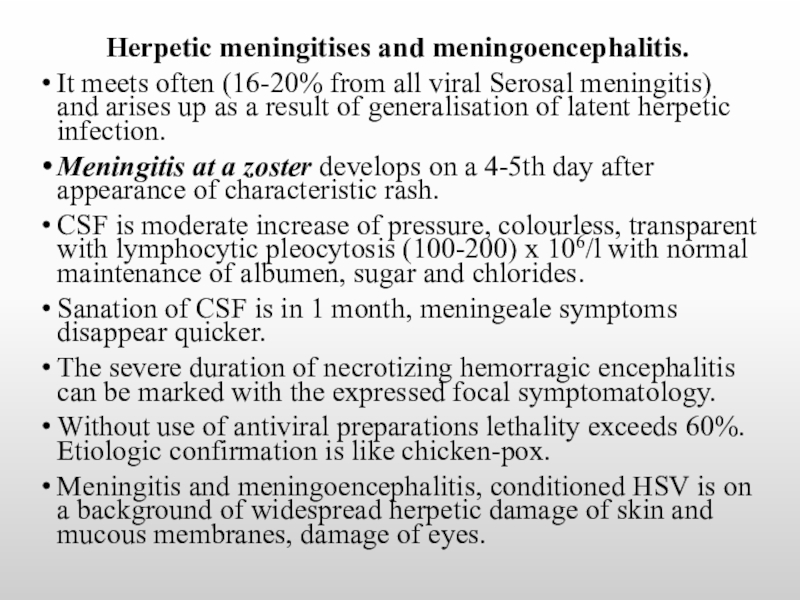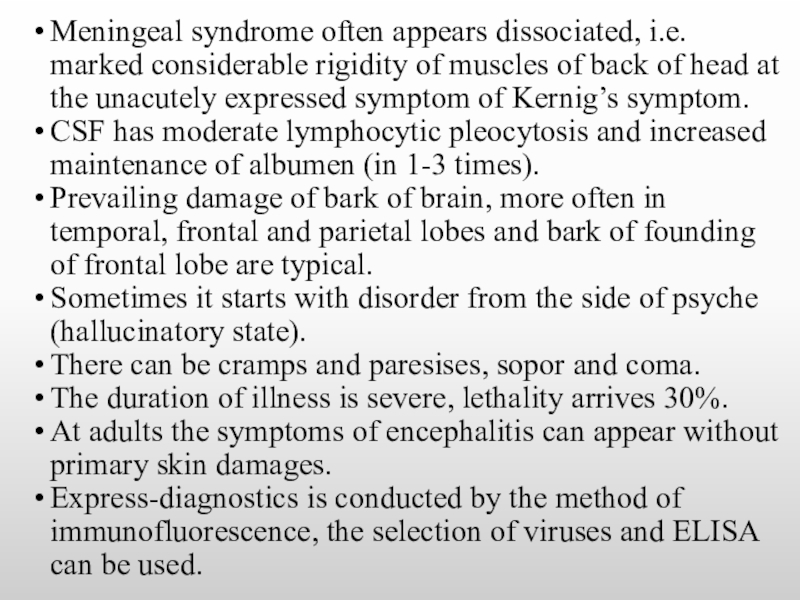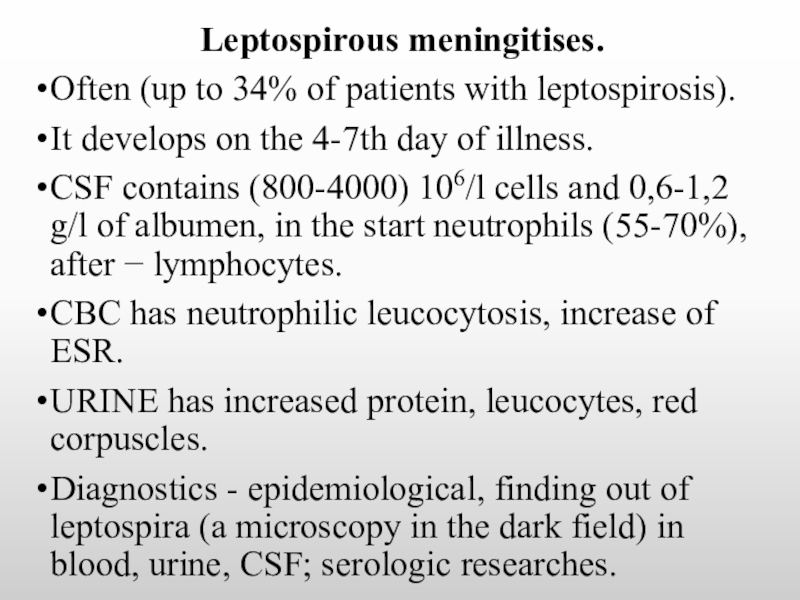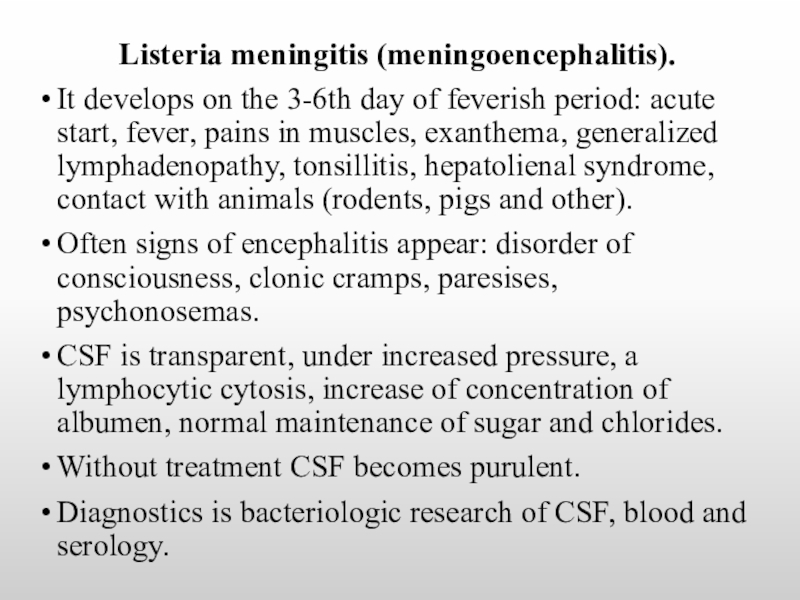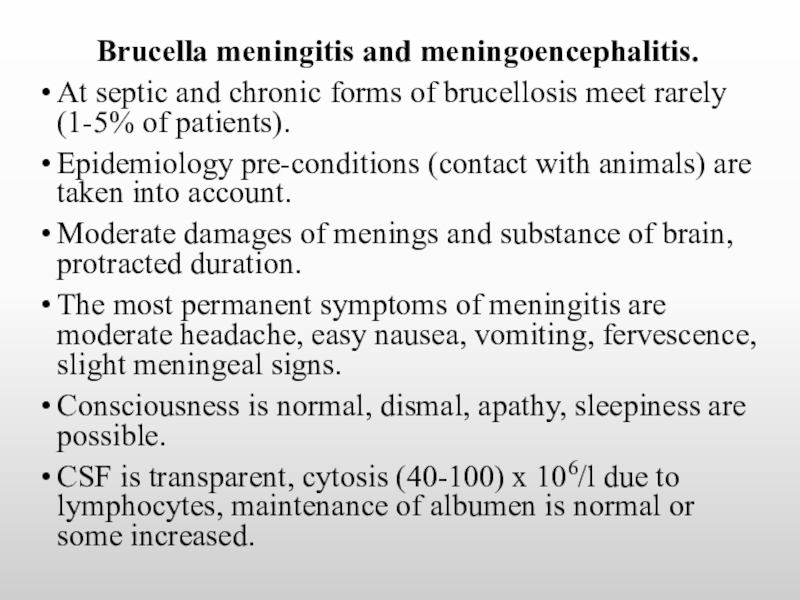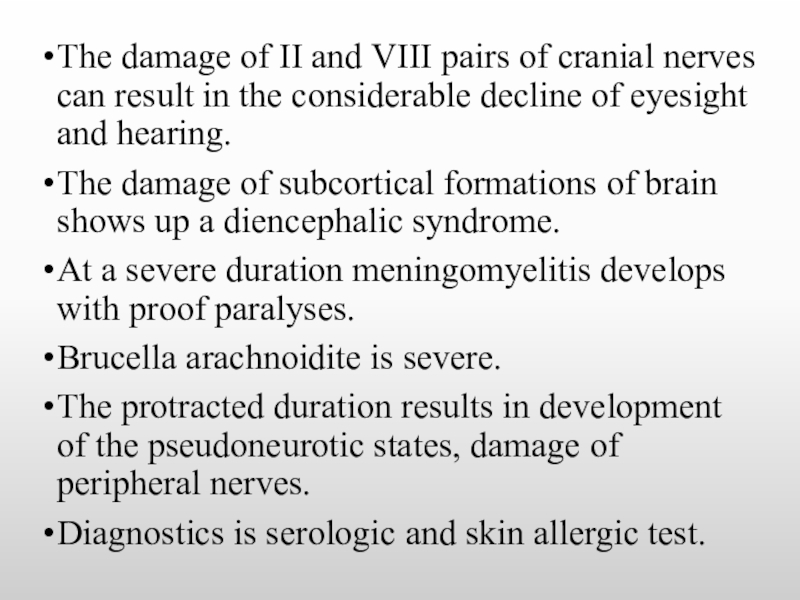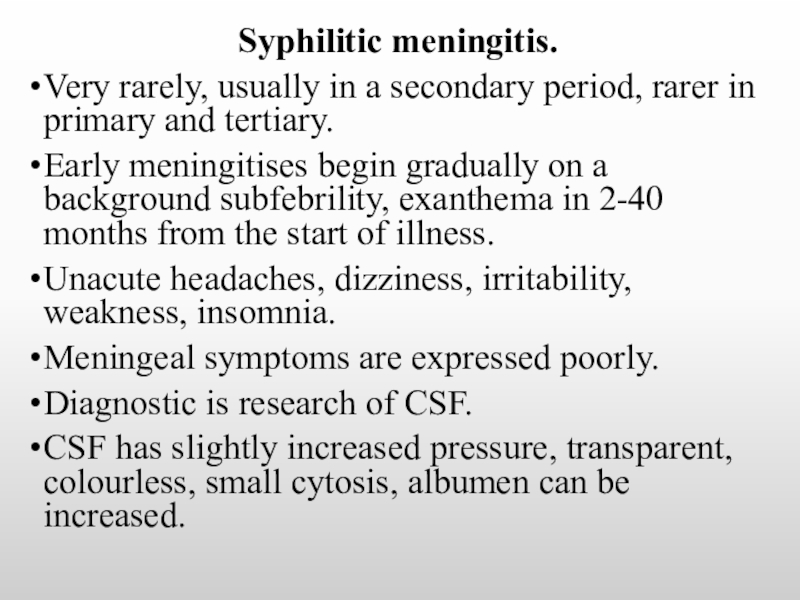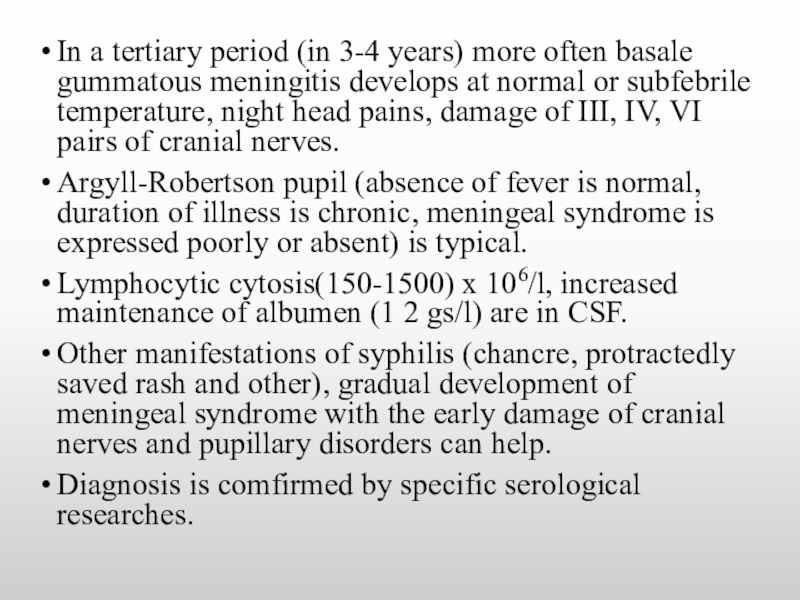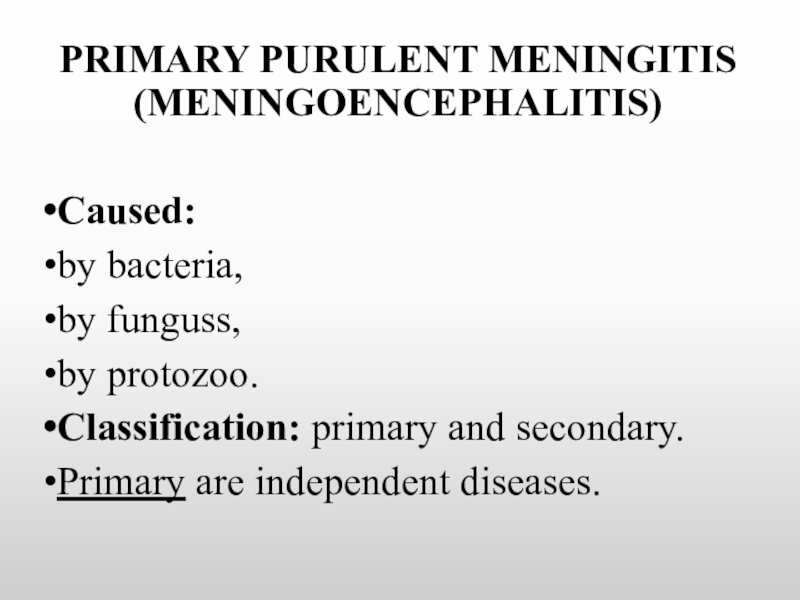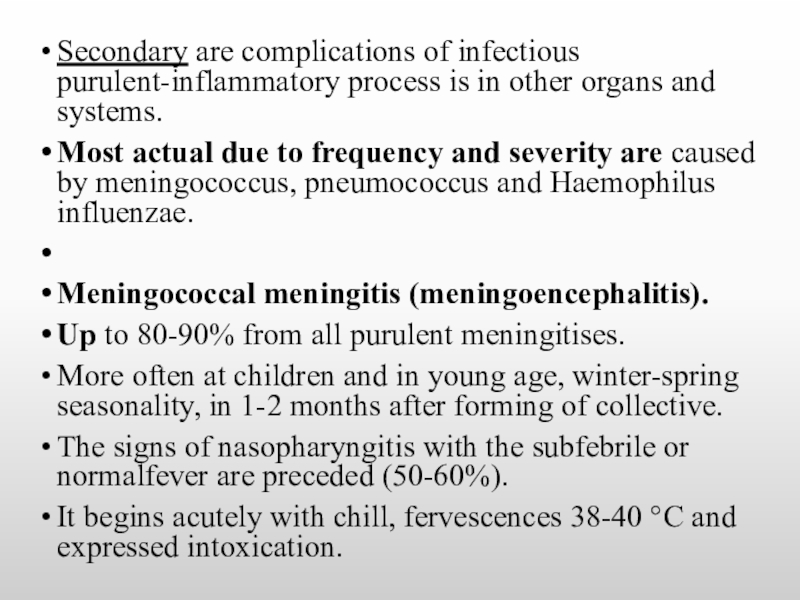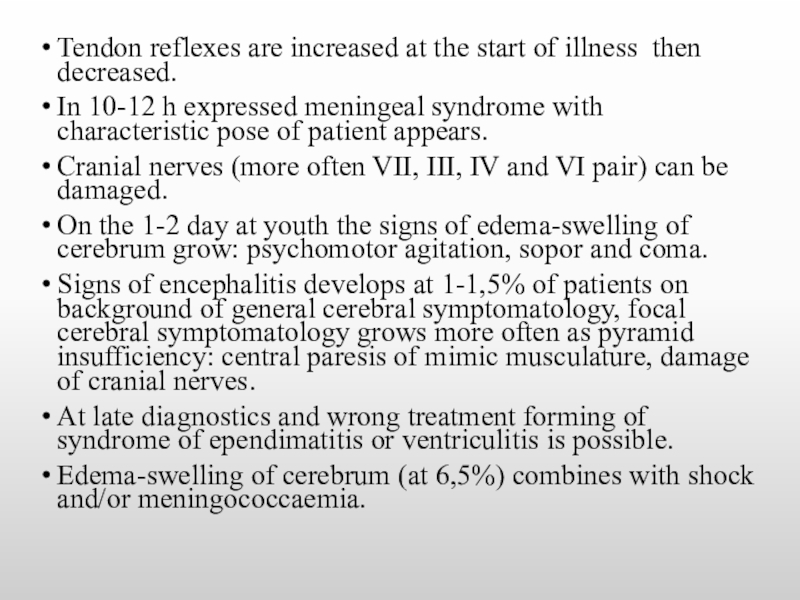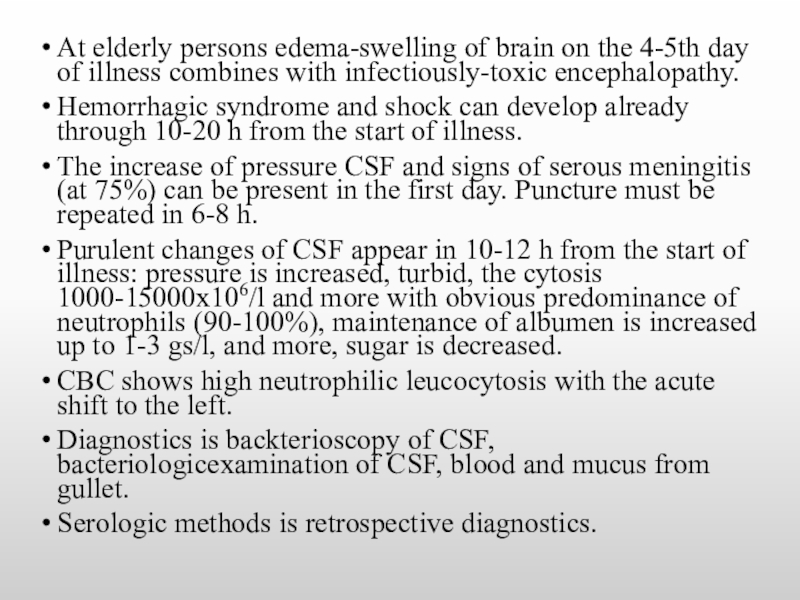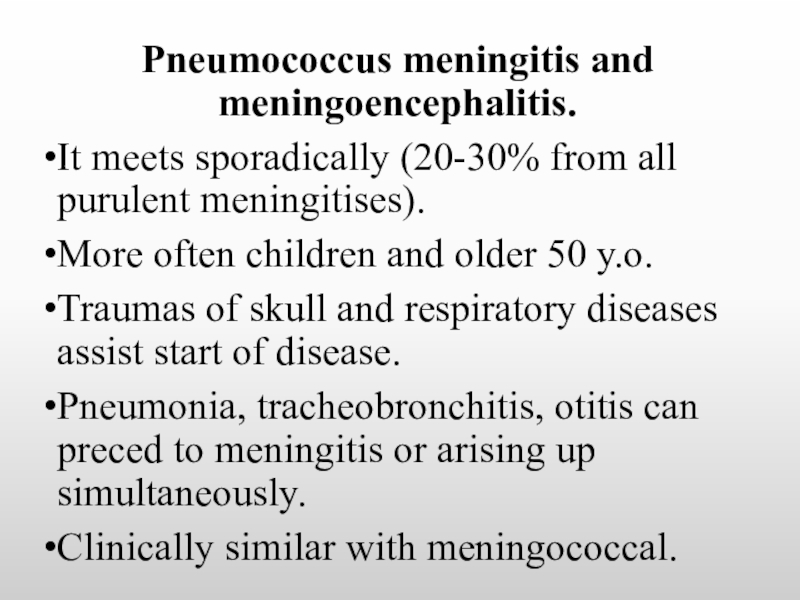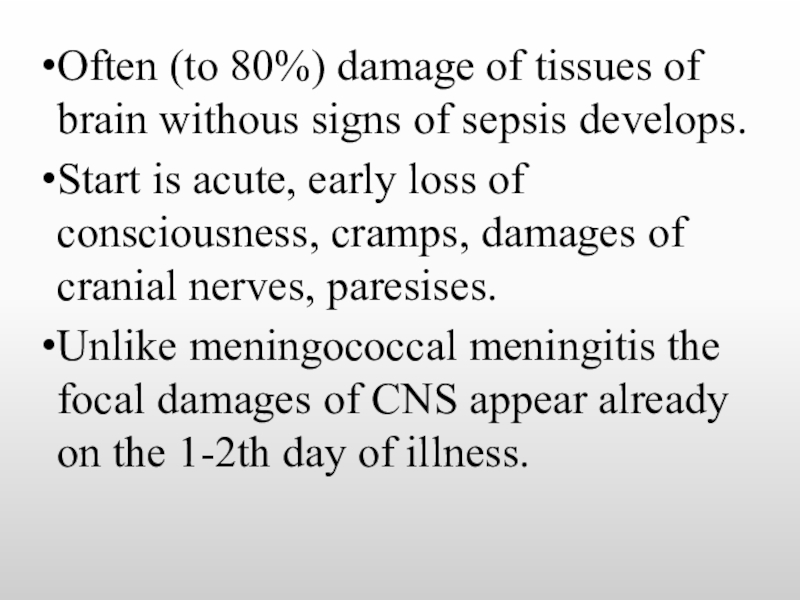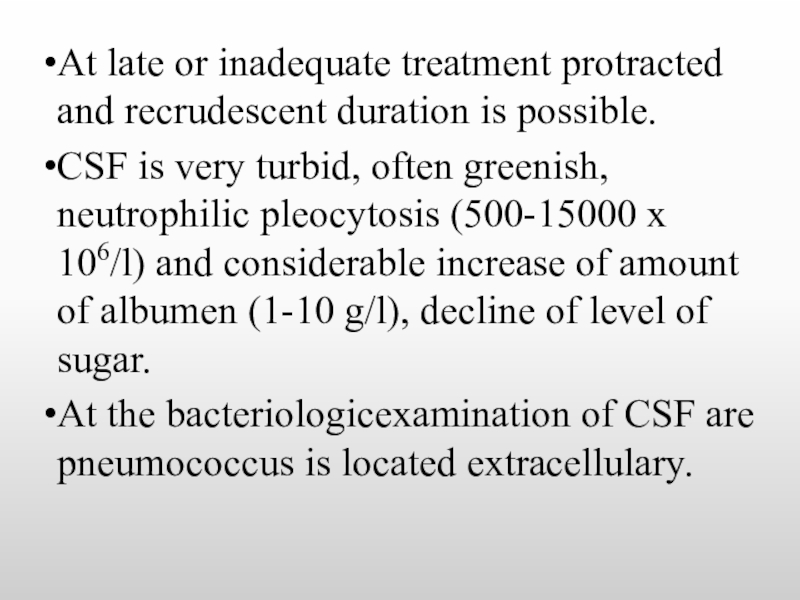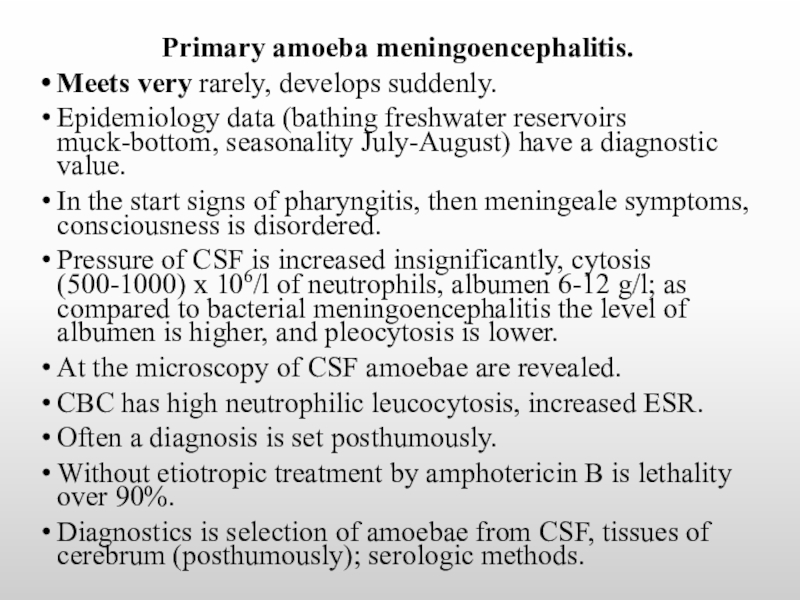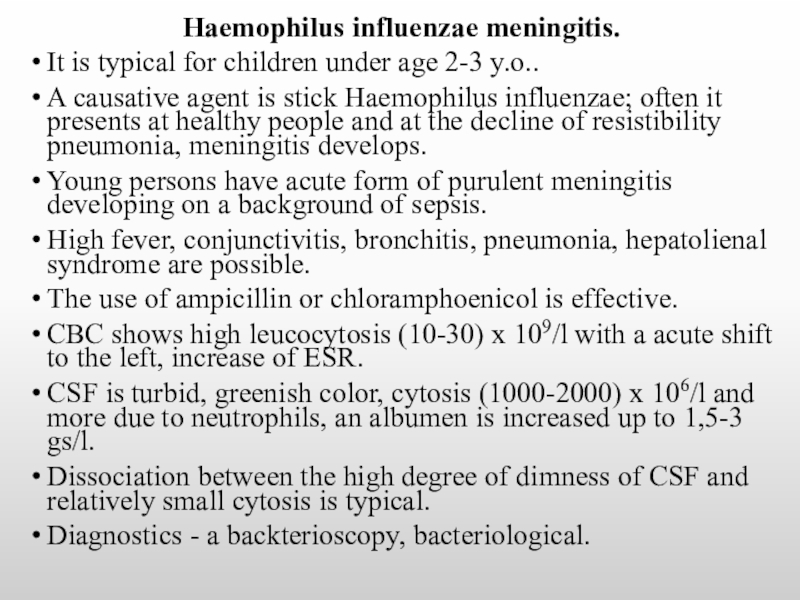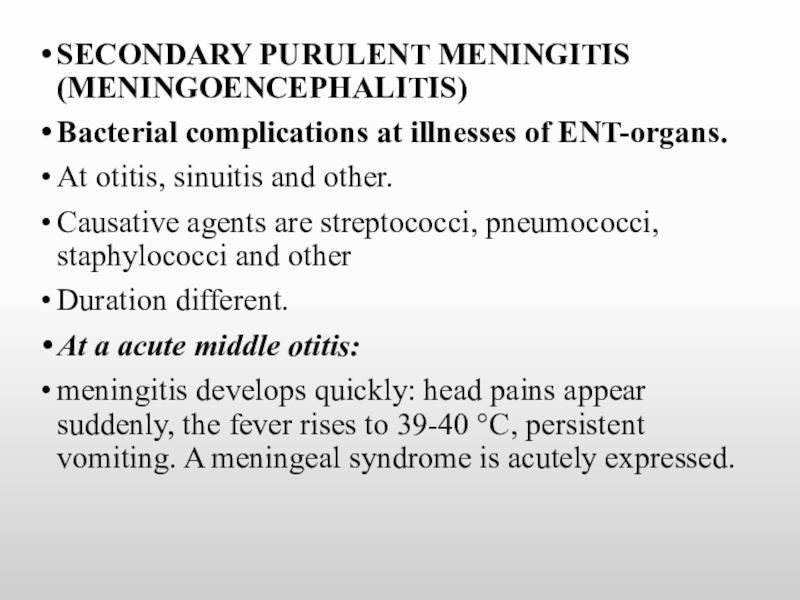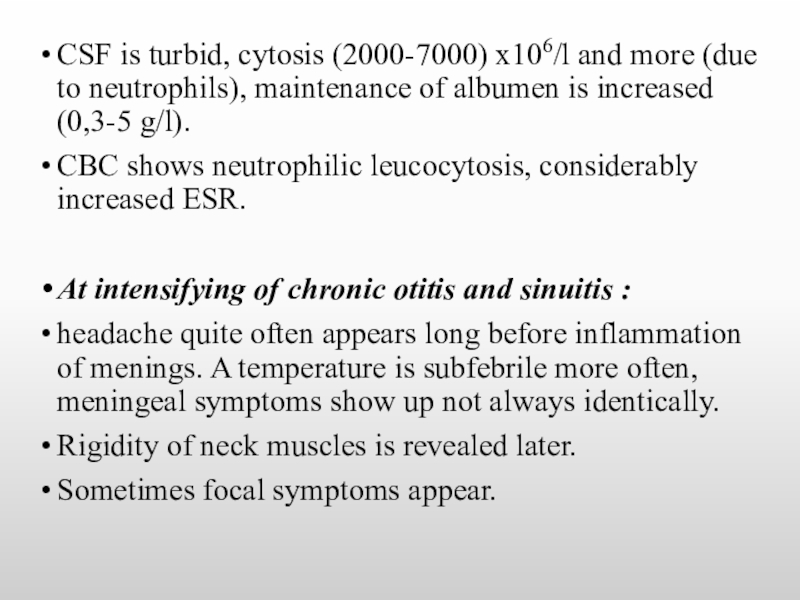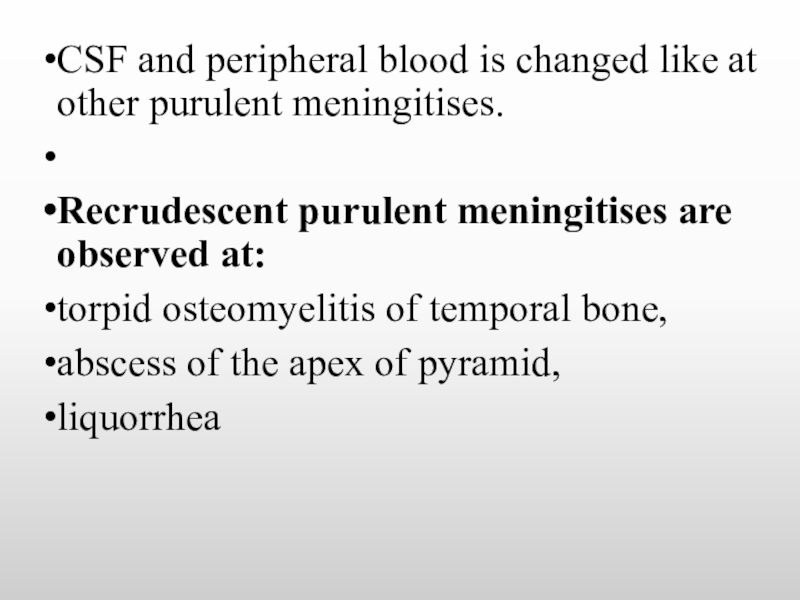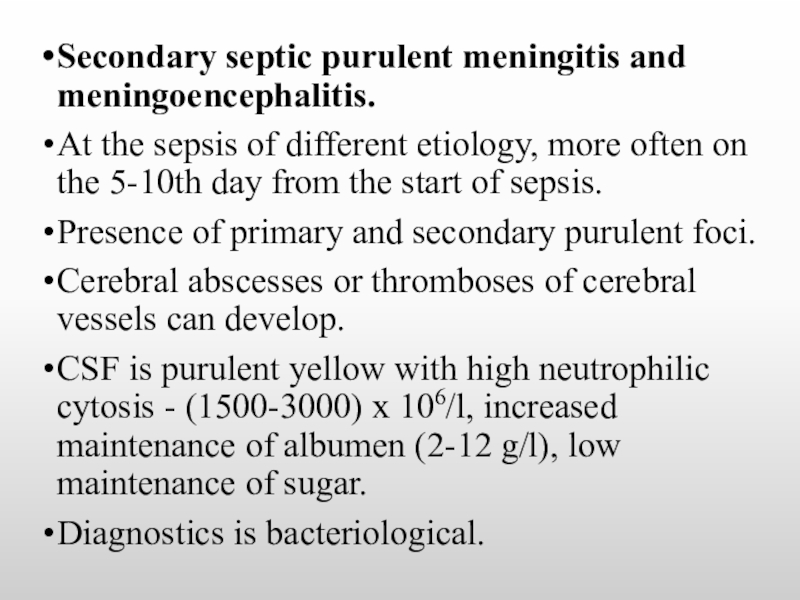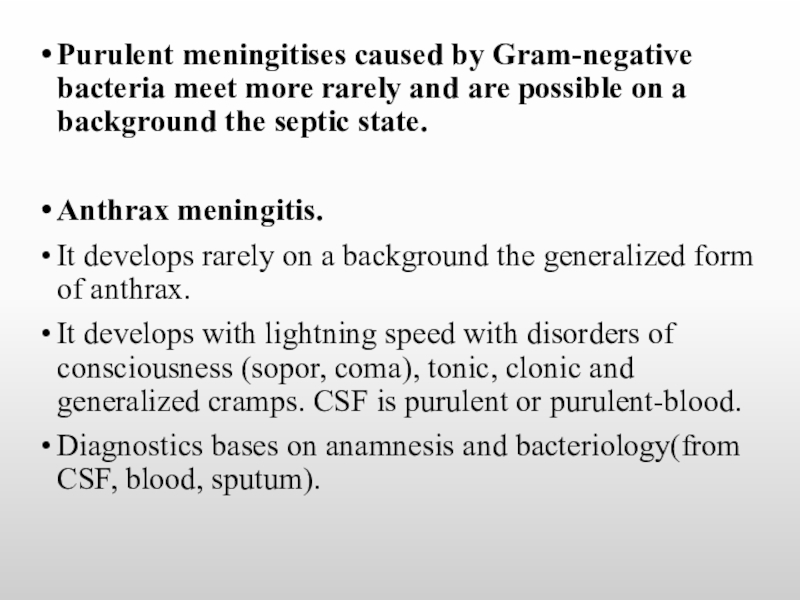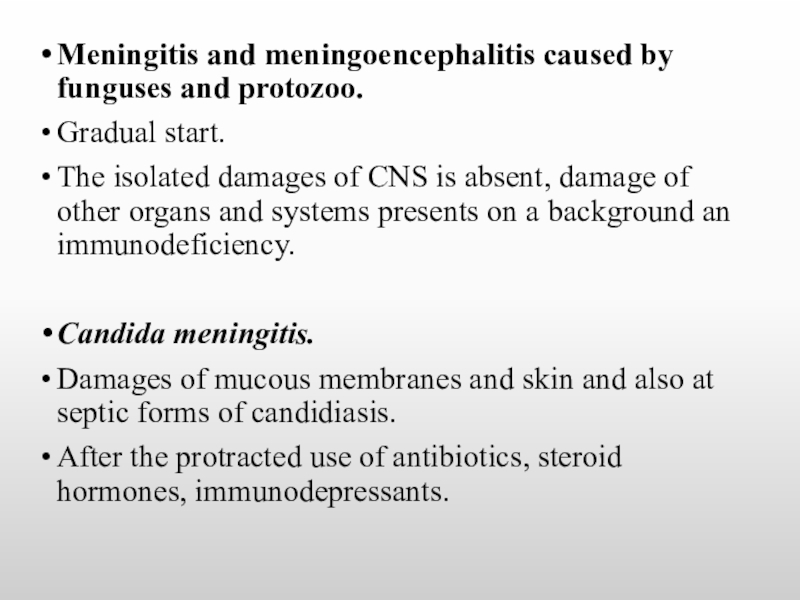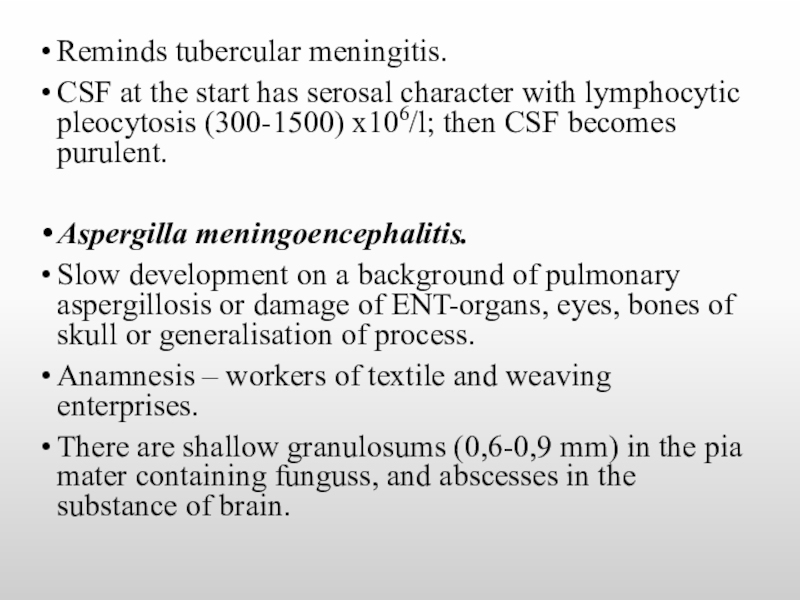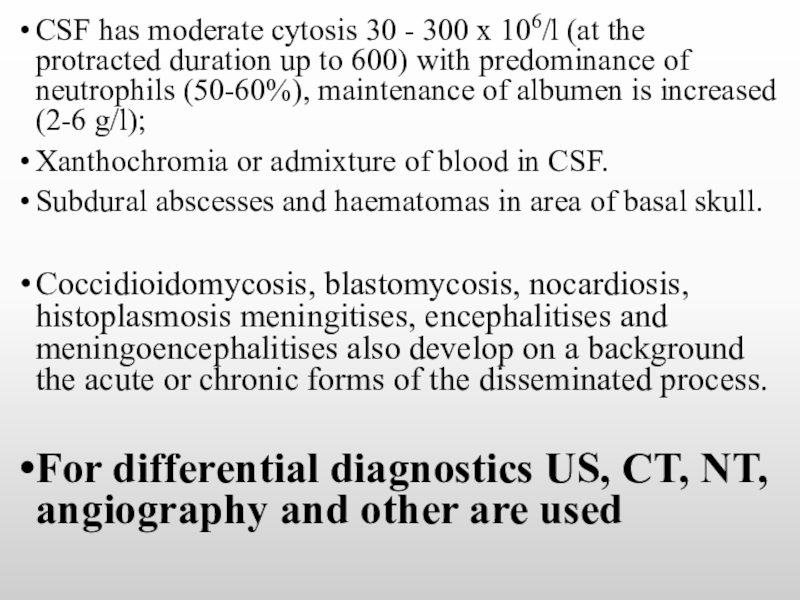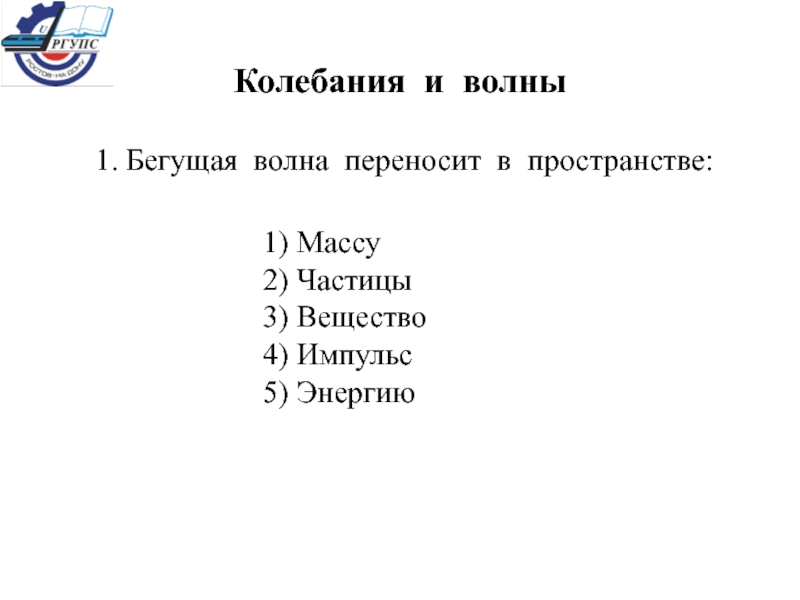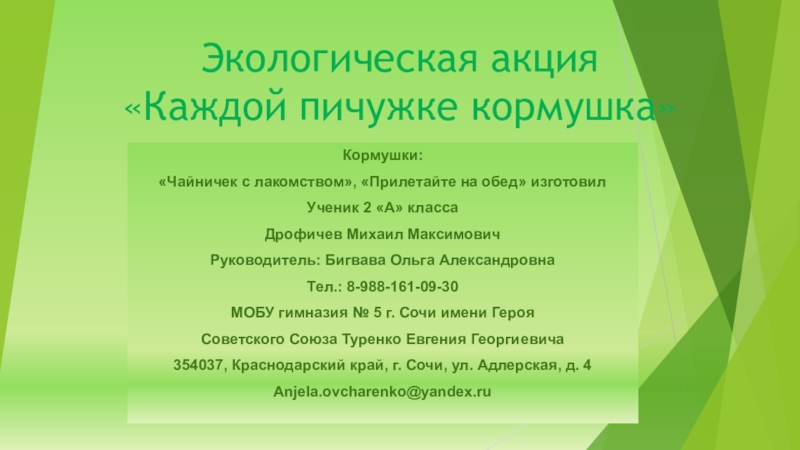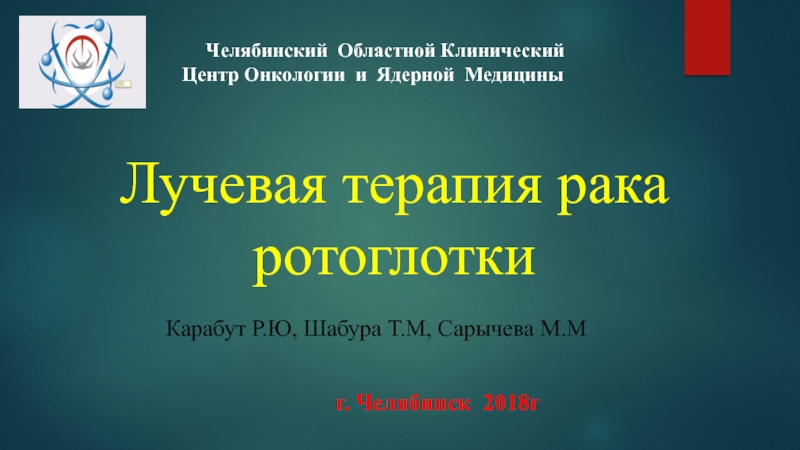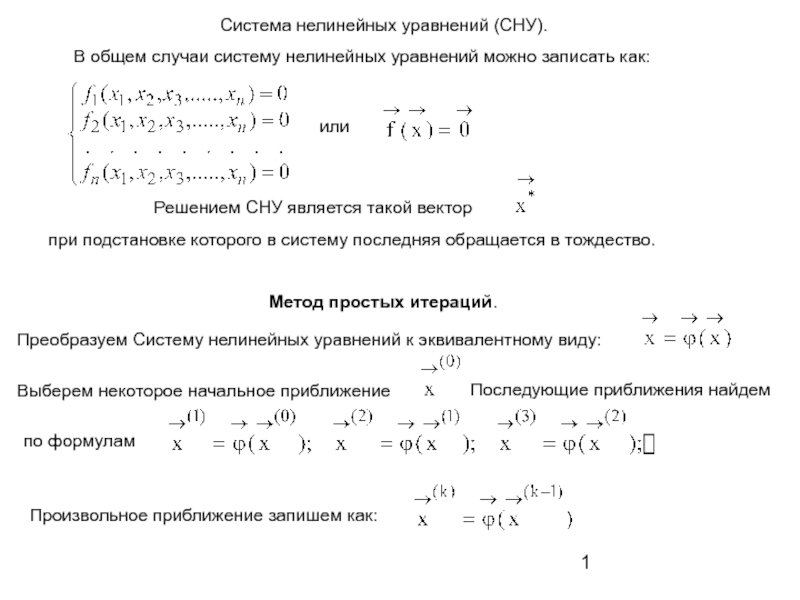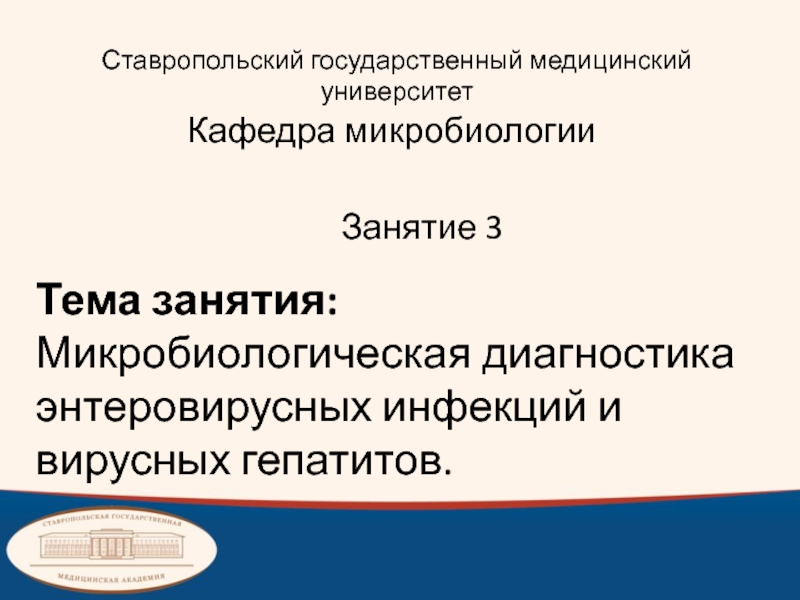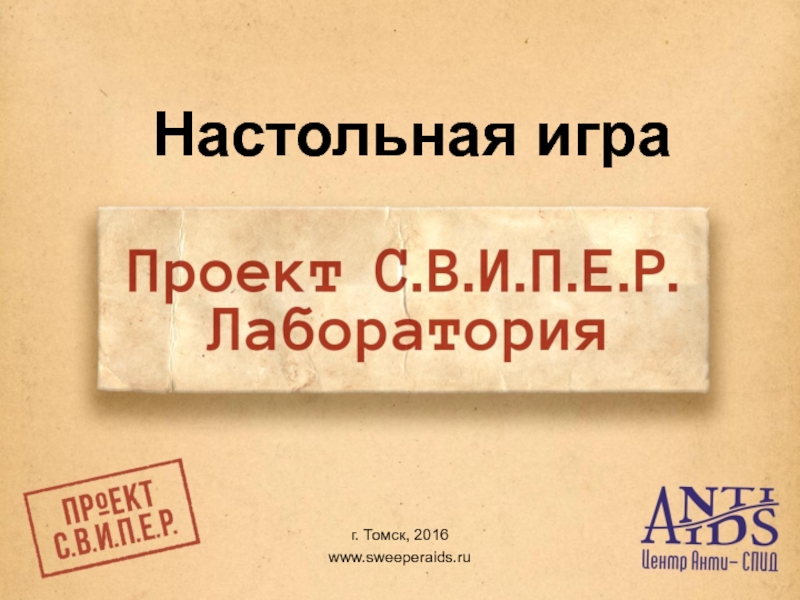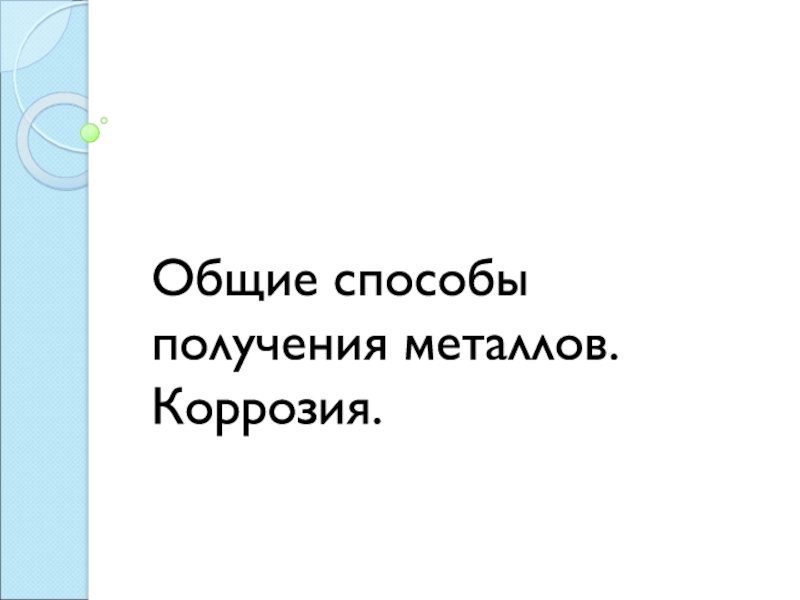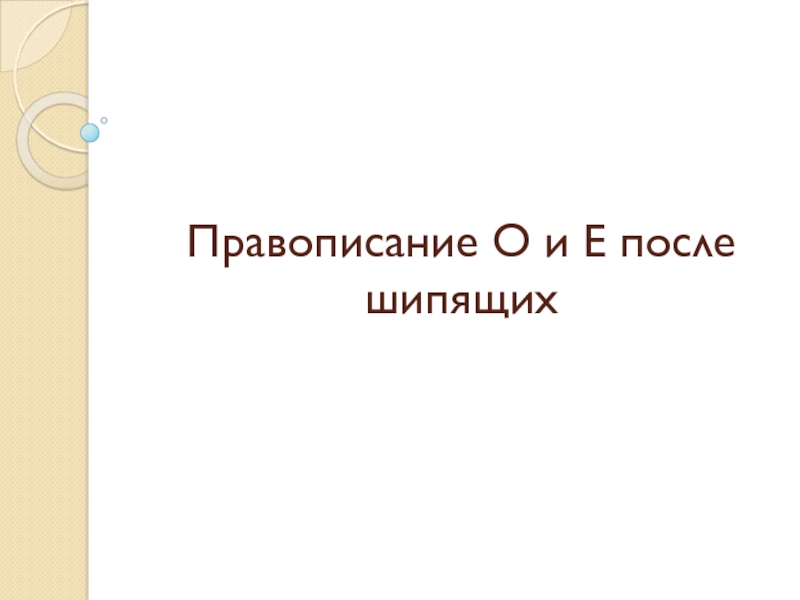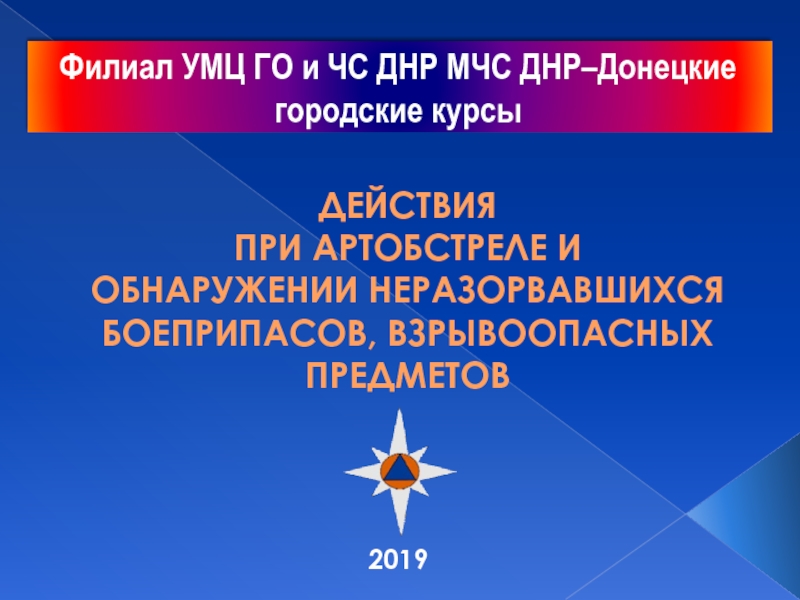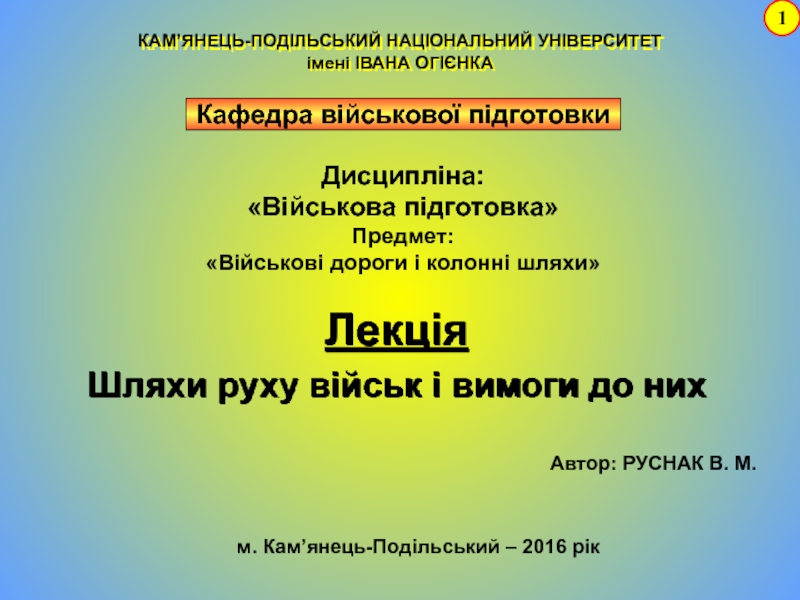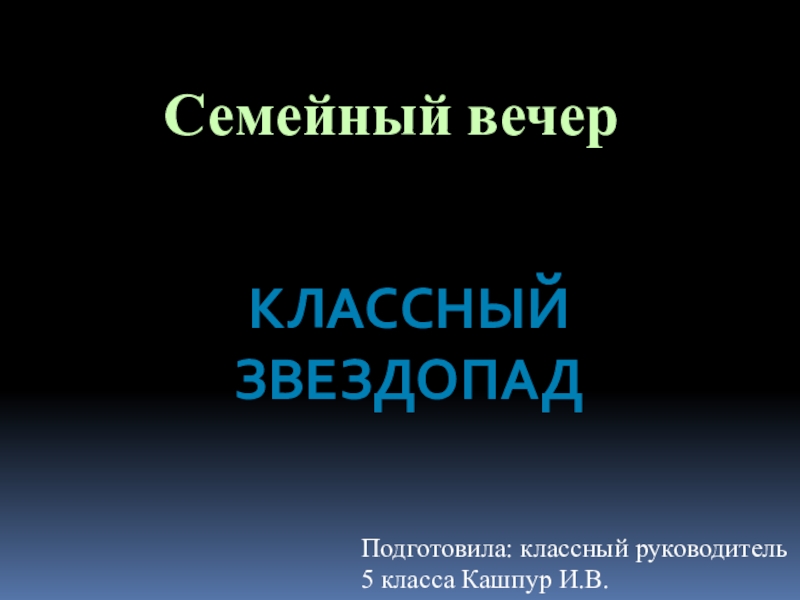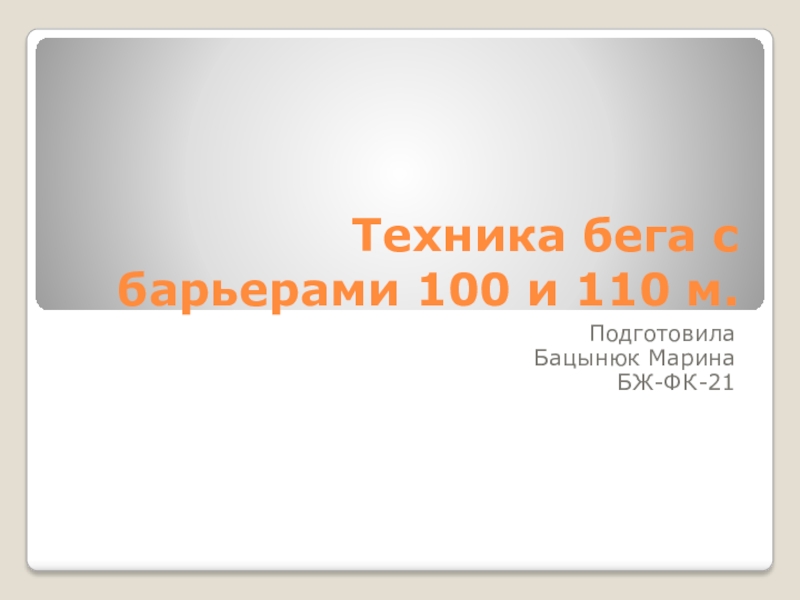Слайд 2Undifferentiated diagnosis of meningitis is set on the basis of
combination of next syndromes : meningeal, syndrome of infectious disease,
changes of neurolymph.
A meningeal syndrome consists of 1) general cerebral and 2) meningeal symptoms.
General cerebral symptoms:
very intensive, painful headache of holding apart diffuse character,
vomiting, quite often without preceding nausea and relief;
psychomotor agitation at severe duration,
delirium, hallucinations,
cramps, flabbiness and disorders of consciousness (stupor, sopor, coma).
Слайд 32. Actually meningealе symptoms can be divided into 4 groups.
1-
group is general hyperesthesia:
increased sensitiveness to the irritants of sense-organs:
photophobia, hyperacusia, skin hyperesthesia.
2- group of muscular tonic tensions:
rigidity of cervical muscles,
Kernig’s symptom,
Brudzinsky’s symptoms (upper, middle and lower).
Слайд 4rigidity of long muscles of back; patient is bent back
and can not flex forward (the pose of patient is
characteristic: a head is thrown back, a trunk is maximally unbended, feet are flexed to the stomach, a stomach is pulled in)
new-born and infants have Lessage’s symptom («suspension»), tension and thrusting out of prefontanel (intracraneal hypertension).
it is necessary to differentiate false rigidity of muscles from pain (myositis, radiculitis etc.): at slow and smooth bending of head rigidity of cervical muscles is not marked but appears at the rapid and intensive bending of head as a result of pain reaction.
Слайд 53-group of reactive pain phenomena. Tenderness at
pressing on :
eyeballs,
places of exit on face of branches of trifacial,
places
of exit of large cervical nerves (points of Kerer);
on the front wall of acoustic duct (symptom of Mendel);
strengthening of headache and pain grimace at percussion of zygomatic arcs and skull.
4-group of change of abdominal, periosteal and tendon reflexes :
in the start their revival and then decline.
Слайд 6At meningitises the signs of encephalitis or myelities are revealed
quite often, diagnostics and estimation of symptoms of encephalitis must
be conducted with participation a neurologist.
At meningitises (meningoencephalitis) the row of syndromes and symptoms characteristic for infectious diseases are revealed :
general intoxication,
fever,
exanthema and enanthema,
lymphadenopathy,
increase of liver and spleen,
change of functions of different organs and systems.
Слайд 7Research of neurolymph (CSF) is needed for confirmation of diagnosis
of meningitis.
Indication for spinal puncture is appearance of meningeal
symptoms.
Normal CSF :
transparent and colourless,
at a lumbar puncture pressure is 100-200 mm H2O (0,98-0,96 кPа),
lymphocytes (2-10) х 106/л,
protein 0,23-0,33 g/l,
chlorides 120-130 mmol/l,
sugar 0,42-0,6 g/l (not below 50% from level in the serum of blood).
Слайд 8A meningism is the state of presence of clinical and
general cerebral meningealой symptomatology without the inflammatory changes of CSF
with increased pressure.
The clinical signs of meningism are not caused by inflammation of brain-tunics but accompined by toxic irritation and increase of intracraneal pressure.
It can be observed at flu, quinsy, typhoid and other illnesses.
It more often meets at children in the acute period of illness and as a rule lasts no more than 1-3 days.
After spinal puncture the state of patients gets better quickly and meningeal signs disappear soon.
A meningism can preced to inflammation of meninxes.
If the meningealе phenomena do not disappear and grow it is necessary to do repeated diagnostic spinal puncture.
Слайд 9Depending on indexes of CSF meningitises and meningoencephalitis can be
serosal or purulent.
Serosal CSF is transparent or opalescent with moderate
pleocytosis (from a few tens to a few hundreds cells in 1 mm3, mainly lymphocytes).
Purulent CSF is turbid with high neutrophilic pleocytosis and increased maintenance of albumen.
Serosal meningitis can be viral or bacterial etiology, primary or secondary.
Serosal meningitises viral etiology without damages of internalss are primary.
Diseases with the damage of nervous system and other organs and systems behave to the secondary serosal meningitis and meningoencephalitis.
Слайд 10PRIMARY SEROSAL MENINGITIS (MENINGOENCEPHALITIS)
lymphocytic choriomeningitis,
toxoplasmatic meningoencephalitis,
tickborn and Japanese
encephalitises,
tubercular meningitis.
Слайд 11 Acute lymphocytic choriomeningitis.
1) 2-5% of serosal meningitis.
2) At 60% it begins
as the isolated meningitis or meningoencephalitis.
3) At 30% high fever
during 4-6 days and symptoms of general intoxication are preceded appearance of meningeal syndrome.
4) At 10% meningeal syndrome develops after an initial period as acute inflammation of mucous membranes of upper respiratory tracts.
5) Changes on an eyeground, transitory paresises of eye and mimic muscles can be revealed.
6) CSF is transparent, rarer opalescent, cytosis is up to 2000 х 10^6/l with predominance of lymphocytes (70-90%), maintenance of albumen rises (in 2-4 times), the level of sugar is some decreased, chlorides are without changes.
7) After lumbar puncture the state of patients gets better substantially.
8) Some patients have the unacutely expressed objective signs of encephalitis : pyramid signs, paresises of cranial nerves, decline and unevenness of tendon reflexes and other
Слайд 129) Sometimes at severe duration signs of encephalomyelitis and poliomyelitis can
be marked, in blood small leucocytosis,(9-10) х 109/l, increase of
ESR are revealed.
10) At majority temperature normalizes in 4-10 days,
11) Meningeal symptoms pass through 6-15 days (sometimes − till 1 month),
12) CSF is normalized in 15-35 days.
13) Paresises also pass relatively quickly.
14) The chronic form of lymphocytic choriomeningitis (general weakness, headache, dizziness, decline of memory, then damages of cranial nerves, paresises and paralyses of extremities) lasts up to 10 years and finishs by death.
15) Clinical diagnostics is very difficult.
16) Epidemiology data (contact with rodents, hamsters).
17) It is confirmed laboratory by the selection of virus (arenavirus) or growth of specific antibodies in 4 times and more.
Слайд 13Toxoplasm meningoencephalitis.
1) It is result of generalization of chronic toxoplasmosis
or latent infection.
2) The fever 39 40 °С, head pain, vomiting,
cramps, hallucinations, meningeal syndrome appear.
3) The functions of cranial nerves are disordered, paresises and paralyses of extremities, aphasia develop.
4) On occasion meningitis has subacute duration, slowly progreses like meningoencephalitis with the primary damage of periventricular zone.
5) CSF – cytosis (100-1000) х 106/l with predominance of lymphocytes, large maintenance of albumen (to 6 g/l).
6) Generalized lymphadenopathy, mesadenitis, increase of liver, chorioretinitis, calcification in cerebrum.
7) Diagnostics is discovery of toxoplasm in CSF and serological.
Слайд 14Tick-born encephalitis.
1) Passed by ticks and meets in a spring-summer period.
2) Latent period 8-23 days (more often 10-12).
3) It begins suddenly
with a fervescence (38-40°С), headache, chill, nausea, vomiting, pains in extremities.
4) Children have epileptiform attacks sometimes.
5) Part of patients has the prodromal phenomena (weakness, malaise). Hyperemia of face, neck, injection of vessels of sclera are marked.
Слайд 156) Disease can durate with intoxication manifestations only or with the
syndrome of serous meningitis, encephalopoliomyelitis, meningoencephalitis.
7) It more often develops in
mild and erased forms with a short feverish period.
8) Clinical forms with a general cerebral and meningeal syndromes are benign.
9) Severe forms of encephalitis develops protractedly (till 2 years) often with incomplete renewal of functions in a decubation and disability.
10) Lethality is from 5 to 30%.
11) At 20% syndrome of polyencephalomyelitis is with the damage of nervous cells of front horns of neck department of spinal cord and nucleuses of oblong brain develop.
Слайд 1612) Paralyses of neck-humeral muscles (symptom of «hang-on of head»), damage
of IX, X, XII pairs of cranial nerves, bulbar disorders
(disorders of swallowing, speech, breathing) are typical, ascending paralyses develop rarely.
13) Hemiparesis develops at 14% patients.
14) There can be epileptiform attacks.
15) CSF is transparent, pleocytosis (12-100) of х 10^6/l with predominance of lymphocytes (50-60%), the amount of albumen is increased (0,5-2 gs/l).
16) Cytosis does not correlate with severity of illness.
17) In blood leucocytosis (10-12) of х 109/l, lymphopenia, eosinopenia, increase of ESR.
18) PCR of CSF and growth of title of antibodies confirm diagnosis.
Слайд 17Japanese (mosquito) encephalitis.
1) Meets in the south districts of Primorsky Kray.
2) Durations is heavier than tick meningoencephalitis.
Hydrophobia.
1) Before development of the paralytic
stage it is characterized by the original duration of initial period (hydrophobia, aerophobia, salivation, delirium, hallucinations, agitation).
2) Epidemiology pre-conditions (bite of animals) is taken into account.
Слайд 18Tubercular meningitis and meningoencephalitis.
1) About 3% of all tuberculosis (at adults).
2) Gradual development.
3) Subfebrility, adinamia, asthenia, sleepiness or insomnia is marked in
first 7-14 days, loss of appetite, vomiting, vegetative-vascular disorders (red spots on the body) appear.
4) By the end of initial period bradicardia replaced by tachycardia.
5) Headache grows in forehead and back of head.
6) On the 2-3th week headache becomes very acute, increases at the change of position of body and concussion.
7) Fever arrives high level (38-39 °С).
Слайд 198) Hyperkinesias as a large shaking of extremities, paresises and paralyses,
disorders of speech (aphasia) can develop.
9) Early diagnostics is analysis of
CSF.
10) CSF is transparent, sometimes opalescent, very rarely − turbid, cytosis (100-300) х 106/l. At initial period it can be with considerable maintenance of neutrophils (30-50%), main period has lymphocytic cytosis ap to 500 х 106/l; an albumen is increased 0,6 g/l and higher; sugar and chlorides go (in 2-2,5 and in 1,5 time, accordingly) down.
11)Tender fibrinous tape appears in 12-24 h in taken CSF.
12) Diagnostics bases on discovery of causative agent in CSF, serological and allergological methods.
Слайд 20SECONDARY SEROSAL MENINGITIS (meningoencephalitis)
Combinations of serous meningitis or meningoencephalitis is
possible with other manifestations of nosology forms is one of
syndromes of illness or complication.
Parotitis meningitis (meningoencephalitis).
1) The clinical signs of epidemic parotitis are revealed.
2) Damage of salivary, pancreas and sexual glands observed at 70-80% of patients.
3) Information about a contact with patients epidemic parotitis have a diagnostic value.
4) It appear, as a rule, at moderate and severe duration of illness.
5) More often it takes place on the 4-7th day after the damage of salivary glands.
6) It is accompanied by a new fervescence 39°C and higher and strengthening of signs of intoxication.
Слайд 217) At part of patients (10%) meningitis develops before clinically expressed
inflammation of salivary glands, and at some patients change of
salivary glands is not revealed.
8) CSF is transparent, with increased pressure, maintenance of albumen is normal or increased to 2,5 g/l, cytosis from few hundreds till 2000 х 109/l due to lymphocytes (85-95%), maintenance of chlorides and sugar is not changed, sometimes tape of fibrin can appear.
9) The symptoms of meningitis and fever disappear in 10-12 days.
10) Sanation of CSF is protracted (up to 40-60 days).
11) The signs of encephalitis or encephalomyelitis develop simultaneously with meningeal symptoms.
12) Diagnostics is laboratory (ELISA, PCR).
Слайд 22At some infectious diseases a serous meningitis (meningoencephalitis) develops in
combination with the syndrome of damage of upper respiratory tracts
(flu, parainfluenza, adenoviral, RS-viral, enterovirus diseases, mycoplasmosis).
Adenoviral Serosal meningitis.
Observed rarely.
Symptoms of rhinopharyngitis, conjunctivitis, lymphadenopathy.
Damage of CNS can appear at the period of height of illness.
Pleocytosis is small −(100-200) х 106/l, lymphocytes (90-95%) prevail.
Duration is mainly benign.
Слайд 23Influenzal meningitis (meningoencephalitis).
During the epidemics of flu, at the
typical duration of illness.
The signs of damage of upper
respiratory tracts are revealed.
During the first two days signs of meningism are possible.
Meningoencephalitis and meningitis develops later − on the 4-6th day of illness.
It is resistant to therapy and conditioned by hemorrhages in meninxes and tissue of brain.
CSF – pressure is high, a cytosis is small (11-200) х 106/l and conditioned by reaction on the RBC in a CSF, albumen is 0,99-3,3 g/l.
At hemorragic meningoencephalitis CSF has blood or xanthochromia.
Meningeal manifestations are poorly expressed.
Severe damages of the substance of brain are possible at hemorrhage.
Diagnostics is virologic or serologic
Слайд 24RS-viral Serosal meningitis.
Rarely, more often children.
High fever, bronchitis, bronchiolitis
with an asthmatic component, pneumonia are marked.
Serosal meningitis can
develop at the mixed infections caused by the association of respiratory viruses (flu, parainfluenza, adenoviruses and other).
In a clinical symptomatology the signs of some one disease predominate usually.
Diagnostics is virologic or serologic.
Слайд 25A serous meningitis of polioviral etiology is one of the
stages of development of poliomyelitis.
It meets rarely, conditioned by
the defects of vaccination.
The syndrome of «small illness» is always preceded similar with the syndrome of acute inflammation of respiratory tracts.
Brief fever (2-4 days), rhinopharyngitis, sometimes dyspepsia (nausea, vomiting).
Sometimes − macular exanthema.
At some patients after a remission 1 to 7 days (more often 2-4 days) «large illness» develops.
The second wave of fever appears with the acute worsening of the state and development of meningeal syndrome.
This meningeal stage lasts 3-5 days.
Tenderness at palpation of peripheral nerves, vegetative disorders
Слайд 26Pressure of CSF is increased, cytosis moderate (15-200) х 106/l
with predominance of lymphocytes (60-70%).
Paralyses appear on the 4-6th day
of meningitis and develop very quickly.
Spinal form of illness is often at paralytic poliomyelitis: paralyses of muscles of extremities, trunk, neck, intercostal musculature and diaphragm.
Pontile form with the isolated facioplegia, bulbar with central disorder of breathing and swallowing can be observed.
Combination of one or another damages is possible.
In the paralytic stage of illness in CSF protein-cellular dissociation (cytosis is decreased, an albumen is increased) is typical.
At meningeal stage recognizing of illness is difficult.
Detection of virus at CSF, blood, feces, serologic methods are used.
Слайд 27Mycoplasm meningitis (meningoencephalitis).
It is rare disease.
It begins subacutely from
subfebrile temperature, moderate myalgia, acute inflammation of respiratory tracts (rhinitis,
pharyngitis, bronchitis, pneumonia) during 7-12 days.
Meningeal syndrome develops on the 6-14th day of illness.
Lymphocytic pleocytosis in CSF is from 80 to 400 х 106/l, albumen rises sometimes.
Rapid improvement (in 2-4 days) after the start of treatment by Tetracyclins.
Without treatment the signs of meningitis, as well as changes of CSF, are saved long (to 30 days).
The signs of encephalitis and myelities appear in 4-5 days after development of meningeal syndrome.
In spite of severe damage of CNS outcome is favourable.
For confirmation of diagnosis finding out mycoplasm in a CSF by immunofluorescent method is used. For retrospective diagnostics serologic methods are used.
Слайд 28Ornithosis serous meningitis.
It meets rarely, can combine with the
damage of lungs (meningopneumonia).
It begins acutely, with the signs
of pneumonia, hallucinations, delirium.
Meningeal syndrome develops on the 1-2th week of illness.
Intoxication increases, signs of damage of cranial nerves and pathological reflexes are possible.
Pressure of CSF is increased, cytosis is small, maintenance of albumen is normal or small increased.
Epidemiology data (contact with birds), hepatolienal syndrome, leucopenia and increased ESR are taken into account.
Diagnostics is laboratory (IHR − 1:512, for CFR − 1:16 and higher).
Слайд 29Morbillous meningitises and meningoencephalitis.
It meets rarely(0,1-0,6% from all patients
with measles).
It appears after formation of exanthema.
Tendon reflexes,
especially on lower limbs, abdominal reflexes are decreased.
CSF cytosis (60-150) х 106/l, lymphocytes prevail.
Fever normalizes in 3-4 days, meningealе signs disappear in 9-14 days.
In 1-5 days temperature rises again, the state of patient gets worse acutely, agitation, delirium, cramps of extremities appear, usually those that in future is paralysed.
Слайд 30At the encephalitises hemiplegia or monoplegia, hyperkinesias, ataxia, damage of
facial, visual and auditory nerves, sometimes with consequences blindness and
deafness.
Paraplegias, disorders of sphincters and sensitiveness can develop at encephalomyelitises.
At the damage of pectoral department of spinal cord there are paralyses of central type (hypertensive), of lumbar area - peripheral type (flaccid paralyses).
Encephalitises durates heavily with high lethality (10-25%).
Diagnosis is comfirmed by selection of virus from CSF, blood and serologic reactions.
Слайд 31Rubella meningoencephalitis.
It meets very rarely (0,02-0,05% from all patients
with german measles).
The signs of meningoencephalitisа appear soon after
deflorescence, rarer on a background of exanthema.
Subfebrile temperature, poorly expressed intoxication, small spotted exanthema, lymphadenopathy, leucopenia, plasmacytosis is typical.
Diagnosis is serologic.
Слайд 32Enterovirus serosal meningitis.
Meet often (12-56% from all Serosal meningitis).
Rarer
− encephalomyelitises. Sometimes − signs of encephalitis.
Often − children and
youth, spring-summer seasonality.
It combines with other manifestations of infection (herpangina, epidemic myalgia, exanthema and other).
Слайд 332-3th wave of fever with intervals is typical.
CSF − increased
pressure, cytosis up to (100-200) х 106/l, lymphocytes more than
50%, albumen is normal or decreased.
Favourable duration and recovery in 2-4 weeks usually without the remaining phenomena are usual.
Diagnostics is selection of viruses (from CSF, blood, pharynx, excrement) and serologic methods.
Слайд 34Varicella Zoster meningitis and meningoencephalitis.
Rarely, on a background the
typical duration of chicken-pox.
CSF has lymphocytic cytosis 200 х 106/l.
The prognosis is favourable, at the encephalitises − serious.
It is possible to find out a virus at CSF.
CFR is used with a specific antigen.
Слайд 35Herpetic meningitises and meningoencephalitis.
It meets often (16-20% from all viral
Serosal meningitis) and arises up as a result of generalisation
of latent herpetic infection.
Meningitis at a zoster develops on a 4-5th day after appearance of characteristic rash.
CSF is moderate increase of pressure, colourless, transparent with lymphocytic pleocytosis (100-200) х 106/l with normal maintenance of albumen, sugar and chlorides.
Sanation of CSF is in 1 month, meningealе symptoms disappear quicker.
The severe duration of necrotizing hemorragic encephalitis can be marked with the expressed focal symptomatology.
Without use of antiviral preparations lethality exceeds 60%. Etiologic confirmation is like chicken-pox.
Meningitis and meningoencephalitis, conditioned HSV is on a background of widespread herpetic damage of skin and mucous membranes, damage of eyes.
Слайд 36Meningeal syndrome often appears dissociated, i.e. marked considerable rigidity of
muscles of back of head at the unacutely expressed symptom
of Kernig’s symptom.
CSF has moderate lymphocytic pleocytosis and increased maintenance of albumen (in 1-3 times).
Prevailing damage of bark of brain, more often in temporal, frontal and parietal lobes and bark of founding of frontal lobe are typical.
Sometimes it starts with disorder from the side of psyche (hallucinatory state).
There can be cramps and paresises, sopor and coma.
The duration of illness is severe, lethality arrives 30%.
At adults the symptoms of encephalitis can appear without primary skin damages.
Express-diagnostics is conducted by the method of immunofluorescence, the selection of viruses and ELISA can be used.
Слайд 37Leptospirous meningitises.
Often (up to 34% of patients with leptospirosis).
It
develops on the 4-7th day of illness.
CSF contains (800-4000)
106/l cells and 0,6-1,2 g/l of albumen, in the start neutrophils (55-70%), after − lymphocytes.
CBC has neutrophilic leucocytosis, increase of ESR.
URINE has increased protein, leucocytes, red corpuscles.
Diagnostics - epidemiological, finding out of leptospira (a microscopy in the dark field) in blood, urine, CSF; serologic researches.
Слайд 38Listeria meningitis (meningoencephalitis).
It develops on the 3-6th day of
feverish period: acute start, fever, pains in muscles, exanthema, generalized
lymphadenopathy, tonsillitis, hepatolienal syndrome, contact with animals (rodents, pigs and other).
Often signs of encephalitis appear: disorder of consciousness, clonic cramps, paresises, psychonosemas.
CSF is transparent, under increased pressure, a lymphocytic cytosis, increase of concentration of albumen, normal maintenance of sugar and chlorides.
Without treatment CSF becomes purulent.
Diagnostics is bacteriologic research of CSF, blood and serology.
Слайд 39Brucella meningitis and meningoencephalitis.
At septic and chronic forms of
brucellosis meet rarely (1-5% of patients).
Epidemiology pre-conditions (contact with animals)
are taken into account.
Moderate damages of menings and substance of brain, protracted duration.
The most permanent symptoms of meningitis are moderate headache, easy nausea, vomiting, fervescence, slight meningeal signs.
Consciousness is normal, dismal, apathy, sleepiness are possible.
CSF is transparent, cytosis (40-100) х 106/l due to lymphocytes, maintenance of albumen is normal or some increased.
Слайд 40The damage of II and VIII pairs of cranial nerves
can result in the considerable decline of eyesight and hearing.
The damage of subcortical formations of brain shows up a diencephalic syndrome.
At a severe duration meningomyelitis develops with proof paralyses.
Brucella arachnoidite is severe.
The protracted duration results in development of the pseudoneurotic states, damage of peripheral nerves.
Diagnostics is serologic and skin allergic test.
Слайд 41Syphilitic meningitis.
Very rarely, usually in a secondary period, rarer
in primary and tertiary.
Early meningitises begin gradually on a
background subfebrility, exanthema in 2-40 months from the start of illness.
Unacute headaches, dizziness, irritability, weakness, insomnia.
Meningeal symptoms are expressed poorly.
Diagnostic is research of CSF.
CSF has slightly increased pressure, transparent, colourless, small cytosis, albumen can be increased.
Слайд 42In a tertiary period (in 3-4 years) more often basale
gummatous meningitis develops at normal or subfebrile temperature, night head
pains, damage of III, IV, VI pairs of cranial nerves.
Argyll-Robertson pupil (absence of fever is normal, duration of illness is chronic, meningeal syndrome is expressed poorly or absent) is typical.
Lymphocytic cytosis(150-1500) х 106/l, increased maintenance of albumen (1 2 gs/l) are in CSF.
Other manifestations of syphilis (chancre, protractedly saved rash and other), gradual development of meningeal syndrome with the early damage of cranial nerves and pupillary disorders can help.
Diagnosis is comfirmed by specific serological researches.
Слайд 43PRIMARY PURULENT MENINGITIS (MENINGOENCEPHALITIS)
Caused:
by bacteria,
by funguss,
by protozoo.
Classification: primary and
secondary.
Primary are independent diseases.
Слайд 44Secondary are complications of infectious purulent-inflammatory process is in other
organs and systems.
Most actual due to frequency and severity are
caused by meningococcus, pneumococcus and Haemophilus influenzae.
Meningococcal meningitis (meningoencephalitis).
Up to 80-90% from all purulent meningitises.
More often at children and in young age, winter-spring seasonality, in 1-2 months after forming of collective.
The signs of nasopharyngitis with the subfebrile or normalfever are preceded (50-60%).
It begins acutely with chill, fervescences 38-40 °C and expressed intoxication.
Слайд 45Tendon reflexes are increased at the start of illness then
decreased.
In 10-12 h expressed meningeal syndrome with characteristic pose
of patient appears.
Cranial nerves (more often VII, III, IV and VI pair) can be damaged.
On the 1-2 day at youth the signs of edema-swelling of cerebrum grow: psychomotor agitation, sopor and coma.
Signs of encephalitis develops at 1-1,5% of patients on background of general cerebral symptomatology, focal cerebral symptomatology grows more often as pyramid insufficiency: central paresis of mimic musculature, damage of cranial nerves.
At late diagnostics and wrong treatment forming of syndrome of ependimatitis or ventriculitis is possible.
Edema-swelling of cerebrum (at 6,5%) combines with shock and/or meningococcaemia.
Слайд 46At elderly persons edema-swelling of brain on the 4-5th day
of illness combines with infectiously-toxic encephalopathy.
Hemorrhagic syndrome and shock
can develop already through 10-20 h from the start of illness.
The increase of pressure CSF and signs of serous meningitis (at 75%) can be present in the first day. Puncture must be repeated in 6-8 h.
Purulent changes of CSF appear in 10-12 h from the start of illness: pressure is increased, turbid, the cytosis 1000-15000х106/l and more with obvious predominance of neutrophils (90-100%), maintenance of albumen is increased up to 1-3 gs/l, and more, sugar is decreased.
CBC shows high neutrophilic leucocytosis with the acute shift to the left.
Diagnostics is backterioscopy of CSF, bacteriologicexamination of CSF, blood and mucus from gullet.
Serologic methods is retrospective diagnostics.
Слайд 47Pneumococcus meningitis and meningoencephalitis.
It meets sporadically (20-30% from all
purulent meningitises).
More often children and older 50 y.o.
Traumas
of skull and respiratory diseases assist start of disease.
Pneumonia, tracheobronchitis, otitis can preced to meningitis or arising up simultaneously.
Clinically similar with meningococcal.
Слайд 48Often (to 80%) damage of tissues of brain withous signs
of sepsis develops.
Start is acute, early loss of consciousness, cramps,
damages of cranial nerves, paresises.
Unlike meningococcal meningitis the focal damages of CNS appear already on the 1-2th day of illness.
Слайд 49At late or inadequate treatment protracted and recrudescent duration is
possible.
CSF is very turbid, often greenish, neutrophilic pleocytosis (500-15000 х
106/l) and considerable increase of amount of albumen (1-10 g/l), decline of level of sugar.
At the bacteriologicexamination of CSF are pneumococcus is located extracellulary.
Слайд 50Primary amoeba meningoencephalitis.
Meets very rarely, develops suddenly.
Epidemiology data (bathing freshwater
reservoirs muck-bottom, seasonality July-August) have a diagnostic value.
In the
start signs of pharyngitis, then meningealе symptoms, consciousness is disordered.
Pressure of CSF is increased insignificantly, cytosis (500-1000) х 106/l of neutrophils, albumen 6-12 g/l; as compared to bacterial meningoencephalitis the level of albumen is higher, and pleocytosis is lower.
At the microscopy of CSF amoebae are revealed.
CBC has high neutrophilic leucocytosis, increased ESR.
Often a diagnosis is set posthumously.
Without etiotropic treatment by amphotericin B is lethality over 90%.
Diagnostics is selection of amoebae from CSF, tissues of cerebrum (posthumously); serologic methods.
Слайд 51Haemophilus influenzae meningitis.
It is typical for children under age
2-3 y.o..
A causative agent is stick Haemophilus influenzae; often
it presents at healthy people and at the decline of resistibility pneumonia, meningitis develops.
Young persons have acute form of purulent meningitis developing on a background of sepsis.
High fever, conjunctivitis, bronchitis, pneumonia, hepatolienal syndrome are possible.
The use of ampicillin or chloramphoenicol is effective.
CBC shows high leucocytosis (10-30) х 109/l with a acute shift to the left, increase of ESR.
CSF is turbid, greenish color, cytosis (1000-2000) х 106/l and more due to neutrophils, an albumen is increased up to 1,5-3 gs/l.
Dissociation between the high degree of dimness of CSF and relatively small cytosis is typical.
Diagnostics - a backterioscopy, bacteriological.
Слайд 52SECONDARY PURULENT MENINGITIS (MENINGOENCEPHALITIS)
Bacterial complications at illnesses of ENT-organs.
At
otitis, sinuitis and other.
Causative agents are streptococci, pneumococci, staphylococci and
other
Duration different.
At a acute middle otitis:
meningitis develops quickly: head pains appear suddenly, the fever rises to 39-40 °C, persistent vomiting. A meningeal syndrome is acutely expressed.
Слайд 53CSF is turbid, cytosis (2000-7000) х106/l and more (due to
neutrophils), maintenance of albumen is increased (0,3-5 g/l).
CBC shows
neutrophilic leucocytosis, considerably increased ESR.
At intensifying of chronic otitis and sinuitis :
headache quite often appears long before inflammation of menings. A temperature is subfebrile more often, meningeal symptoms show up not always identically.
Rigidity of neck muscles is revealed later.
Sometimes focal symptoms appear.
Слайд 54CSF and peripheral blood is changed like at other purulent
meningitises.
Recrudescent purulent meningitises are observed at:
torpid osteomyelitis of temporal
bone,
abscess of the apex of pyramid,
liquorrhea
Слайд 55Secondary septic purulent meningitis and meningoencephalitis.
At the sepsis of
different etiology, more often on the 5-10th day from the
start of sepsis.
Presence of primary and secondary purulent foci.
Cerebral abscesses or thromboses of cerebral vessels can develop.
CSF is purulent yellow with high neutrophilic cytosis - (1500-3000) х 106/l, increased maintenance of albumen (2-12 g/l), low maintenance of sugar.
Diagnostics is bacteriological.
Слайд 56Purulent meningitises caused by Gram-negative bacteria meet more rarely and
are possible on a background the septic state.
Anthrax meningitis.
It develops
rarely on a background the generalized form of anthrax.
It develops with lightning speed with disorders of consciousness (sopor, coma), tonic, clonic and generalized cramps. CSF is purulent or purulent-blood.
Diagnostics bases on anamnesis and bacteriology(from CSF, blood, sputum).
Слайд 57Meningitis and meningoencephalitis caused by funguses and protozoo.
Gradual start.
The
isolated damages of CNS is absent, damage of other organs
and systems presents on a background an immunodeficiency.
Candida meningitis.
Damages of mucous membranes and skin and also at septic forms of candidiasis.
After the protracted use of antibiotics, steroid hormones, immunodepressants.
Слайд 58Reminds tubercular meningitis.
CSF at the start has serosal character with
lymphocytic pleocytosis (300-1500) х106/l; then CSF becomes purulent.
Aspergilla meningoencephalitis.
Slow development
on a background of pulmonary aspergillosis or damage of ENT-organs, eyes, bones of skull or generalisation of process.
Anamnesis – workers of textile and weaving enterprises.
There are shallow granulosums (0,6-0,9 mm) in the pia mater containing funguss, and abscesses in the substance of brain.
Слайд 59CSF has moderate cytosis 30 - 300 х 106/l (at
the protracted duration up to 600) with predominance of neutrophils
(50-60%), maintenance of albumen is increased (2-6 g/l);
Xanthochromia or admixture of blood in CSF.
Subdural abscesses and haematomas in area of basal skull.
Coccidioidomycosis, blastomycosis, nocardiosis, histoplasmosis meningitises, encephalitises and meningoencephalitises also develop on a background the acute or chronic forms of the disseminated process.
For differential diagnostics US, CT, NT, angiography and other are used
